HOPE not hate uses cookies to collect information and give you a more personalised experience on our site. You can find more information in our privacy policy. To agree to this, please click accept.

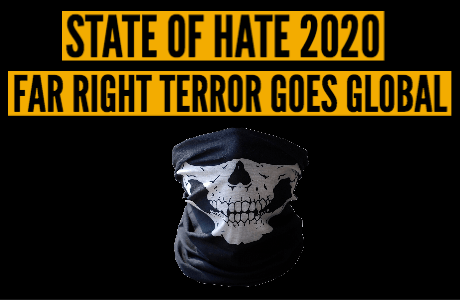
Download the report, or read selected chapters below.

WELCOME TO our new 2020 State of Hate report, our annual review on the state and nature of Britain’s far right, analysing the threat it presents to our nation.
The report – one of our most extensive to date – reveals that there are reasons to be hopeful, but sadly many reasons to be fearful, too.
Our report headlines with two, seemingly contradictory propositions. The traditional far right is at the weakest it has been for possibly 50 years or more – but at the same time hatred is becoming increasingly mainstreamed.
The other key focus of State of Hate this year is the continuing rise of the far-right terror threat, which continues to be a threat both at home – with thwarted plots and numerous arrests – but more significantly is taking on a more global nature and identity, following high-profile attacks in places like New Zealand, the USA and Germany.
We should be vigilant against further terrorism attempts from the extreme right, which currently remain a significant threat.
Our report also explains the current weaknesses of the traditional far right. There are fewer organisations than ever before and those that do exist have been less active and smaller over the past year. There is actually only one far-right group that can be considered to be growing: all the others are in decline or have disappeared altogether.
Language and messaging that was once the preserve of the far right is now increasingly adopted by the political mainstream.
Anti-Muslim prejudice, demeaning rhetoric on migrants and refugees, and notions of a ‘cultural war’ against social liberalism are increasingly being adopted by political and media figures from an increasingly confident political right.
This is partly the consequence of the far right engaging in wider cultural and identity issues, but also because centre-right politicians have tried to embrace far-right narratives to win support. Who really needs far-right propagandists when you have more mainstream commentators like Rod Liddle, Littlejohn, Toby Young and James Delingpole all weighing into the fray?
The ‘cordon sanitaire’ which once kept far-right groups and thought out of mainstream discourse has collapsed, both here and on the Continent.
Belgium’s King Philippe has held an official meeting at the Royal Palace with the head of the far-right Vlaams Belang party. It is the first time a Belgian monarch has met a far-right leader since 1936. In Germany, a significant group of Christian Democrat politicians have called for a deal with the far-right Alternative for Germany party.
The decline of the traditional far right has been happening for some time. As far back as 1999 the British National Party recognised that its strong racist and anti-immigrant message had decreasing traction in a multicultural society where some non-whites were already second or third generation British.
However, this decline has been quickened by the emergence of the internet and the rapidly evolving digital landscape, plus the loosening ties between political parties and people, which has given us all a far wider choice to move between causes and campaigns.
The far right has also been constrained by police action and social media deplatforming. Leaders of many of the more violent far-right groups have been imprisoned, while the action of some social media companies to limit hate speech has massively curtailed the ability of far-right figures to reach audiences and raise money.
When Facebook closed down Stephen Yaxley-Lennon’s [Tommy Robinson’s] page, he lost his ability to reach over one million followers. When far-right party Britain First was taken off Facebook, it lost access to an audience of over two million. While both moved onto the encrypted messaging app Telegram, they can now reach only a fraction of their previous audiences, hampering their visibility and – just as importantly – their ability to raise funds.
But it has been Brexit that has really quickened the far right decline. Brexit has dominated the political discourse over the past three years and the traditional far-right organisations have struggled to get their issues heard amid the Brexit roar. Figures such as Yaxley-Lennon tried to jump aboard the Brexit bandwagon, but after admitting that he hadn’t actually voted in the EU Referendum, he struggled to have any meaningful impact beyond complaining about Muslims and his own sense of persecution.
Last summer, Nigel Farage’s Brexit Party was formed and topped the poll in the European elections all within two months. Along the way it claimed to have recruited 150,000 supporters and millions in donations. However, almost as quickly as it emerged it sunk, as Boris Johnson promised to deliver what Farage could only dream about.
There is a heavy emphasis in this report on the continuing threat of far-right terrorism. Twelve far- right activists were convicted of terrorism-related charges last year, and 10 more are already facing trial this year.
The material being circulated by groups such as the Sonnenkrieg Division and the Feuerkrieg Division is truly horrific and far worse than anything we would have seen in previous far-right groups. More worryingly, these groups are deliberately targeting and attracting young people.
In this report we set out the case for the Home Secretary to proscribe a terror-fomenting group, the Nazi-Satanist organisation the Order of Nine Angles (O9A). While we applaud the decision to ban National Action splinter groups, such as Sonnenkrieg Division, we are mystified why a group that has so consistently advocated terrorism, inspired far-right and Islamist terrorists in the past, and been linked to four people convicted of terrorism last year, is still allowed to operate.
One of the most disturbing features of the violent wing of the far right has been its increasing adoption of sexual violence as a political tool. Domestic abuse, rape and even incest has been openly encouraged. Much of this originates with the O9A, which, as we expose in this report, runs horrendous groups such as ‘RapeWaffen’
The far right are enthusiastic and extreme participants in the culture war and have successfully sought to portray themselves as victims of political correctness, the liberal establishment and gender equality. And in this they successfully tap into an anxiety and lack of control over their lives that many feel, especially those who feel most pessimistic about the future and those who have been top of the social hierarchies but now feel they are losing out to others.
The report explores how the ‘manosphere’ has snowballed into an ideology that has taken on a life beyond an online niche. Though its organised elements and online communities are still a fringe issue, it taps into broader reactionary attitudes towards women, feminism and progressive politics.
While much of State of Hate’s focus is on the British far right, we recognise that overseas events and trends have an impact here.
One significant development of 2019 was how the terrorist wing of the far right now increasingly identifies as a ‘community’. It has now become commonplace for far-right terrorists to integrate a form of social media ‘strategy’ into their attacks.
Far-right terror attacks in New Zealand, the US and Germany all followed a similar theme. Manifestos were written and uploaded ahead of time, sometimes announcements of impending attacks were made and most of the terrorists tried to livestream their atrocities.
With a far-right terrorist MO emerging, we are unfortunately likely to see more of these types of attacks in the future.
The mainstreaming of the far right poses serious challenges for both ourselves, the authorities, minorities, educators and wider society.
It is far easier to challenge the hate of a small group, especially when its views are considered unacceptable by the mainstream, than is the case now – when Islamophobia is on the rise (including inside the governing party), antisemitism is reappearing and other forms of hate crimes are also on the increase.
We are facing challenges on more fronts and in different ways than ever before. We need to challenge hate in mainstream parties, while at the same time tackling the young nazi terrorists operating on the margins. We have to tackle online hate and growing division in our communities.
And just as the traditional and populist far right has crashed in recent times, so it could easily rebound.
Disillusionment with the Boris Johnson government, a frustration over Brexit not delivering as expected, or even other issues becoming more important as Brexit wanes, could all have a galvanising effect on the British far right. And when – or if – this happens, especially if driven by a charismatic leader, this will be tapping into a far bigger pool of support than would have been the case in the past.
The face of hate has changed, and will no doubt change again in the future. We must face that evolving threat with courage and a willingness to adapt to the challenges it presents.
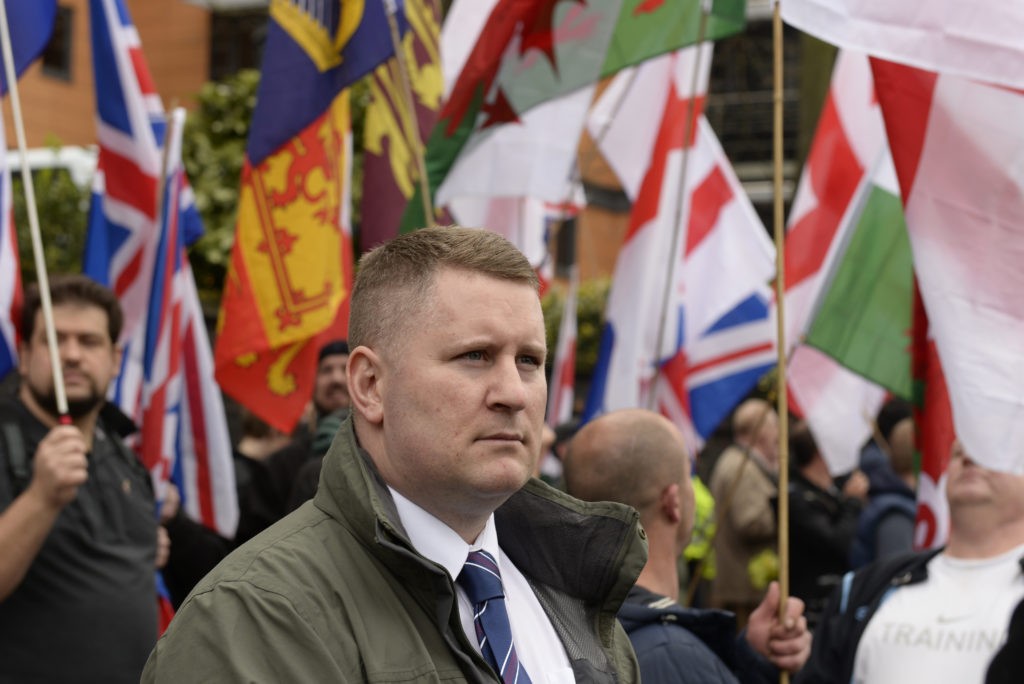
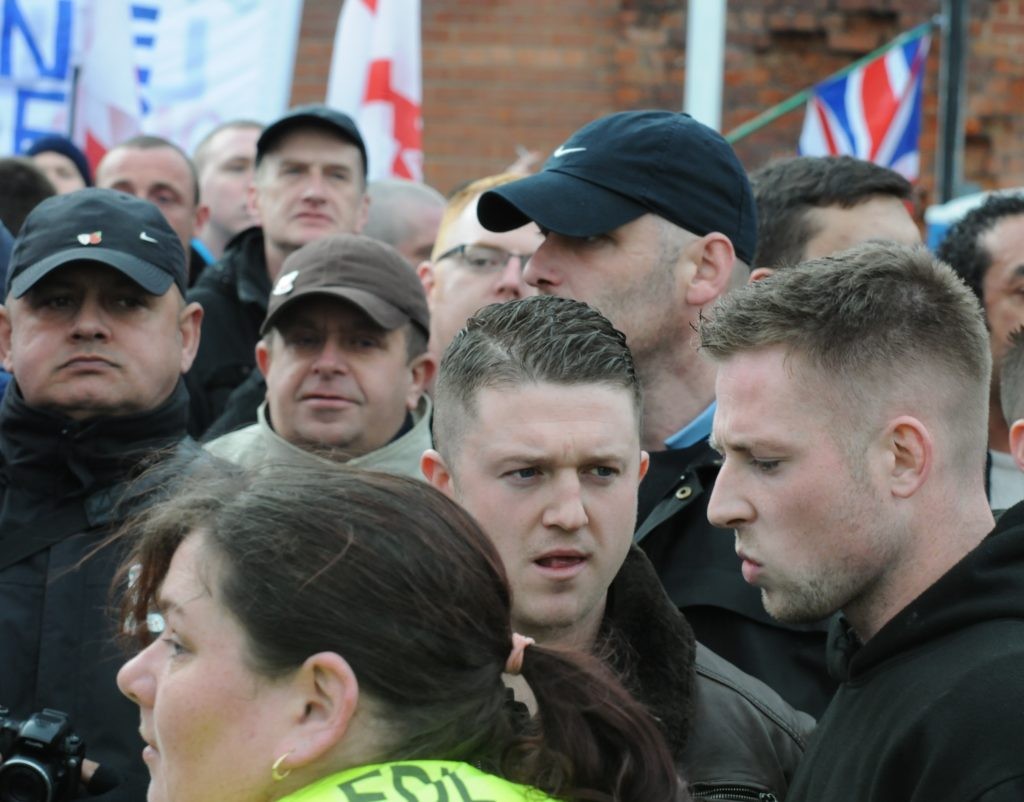
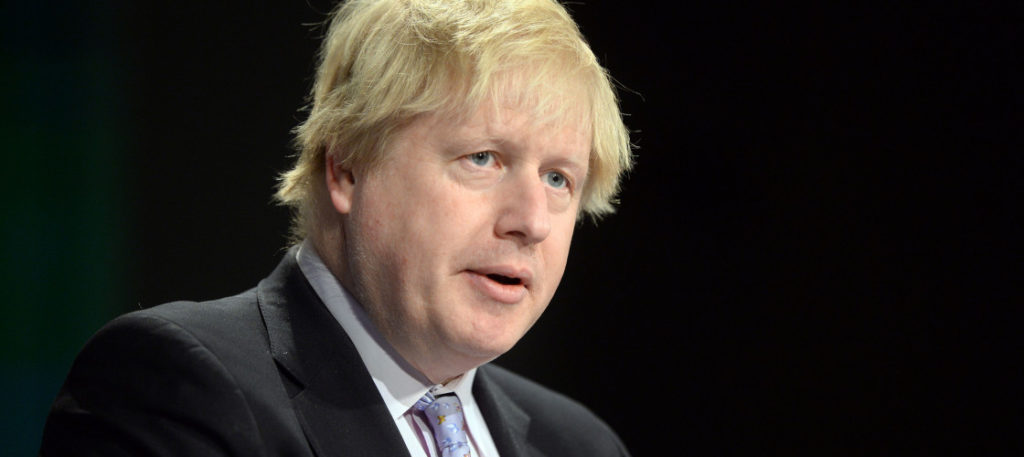
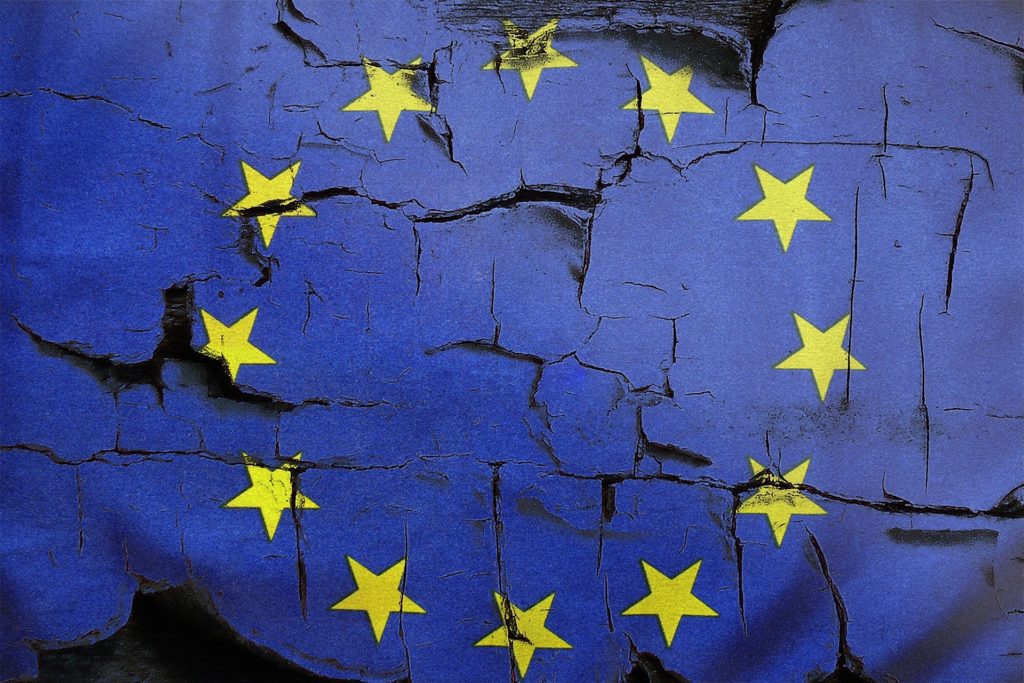
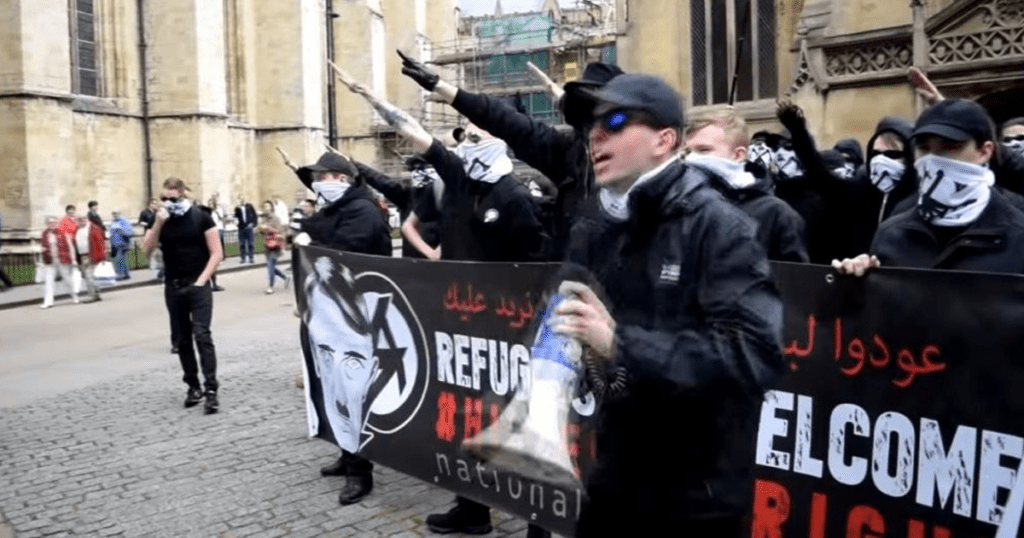
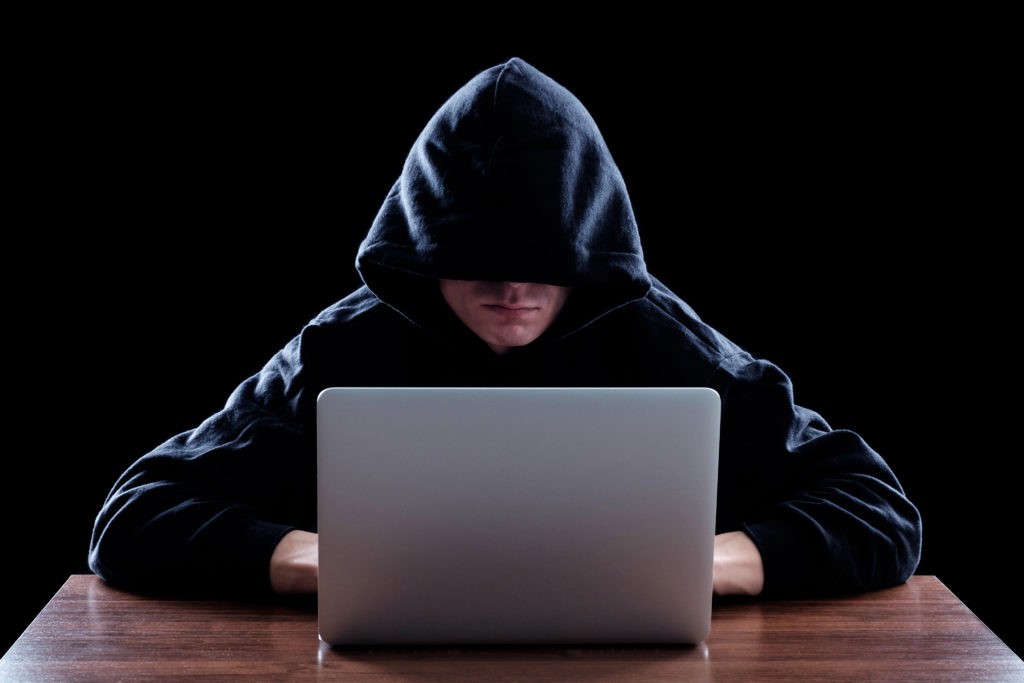
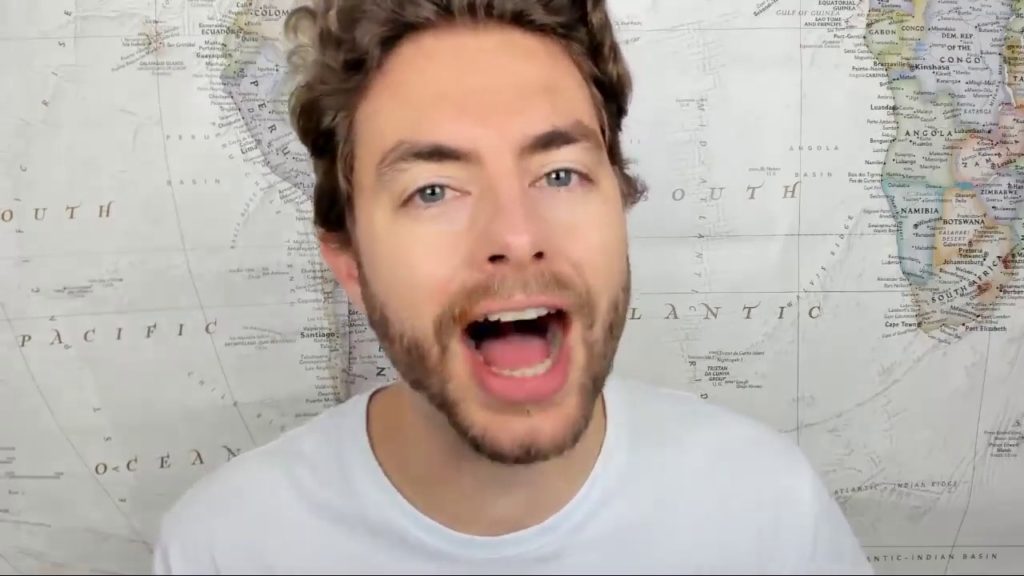
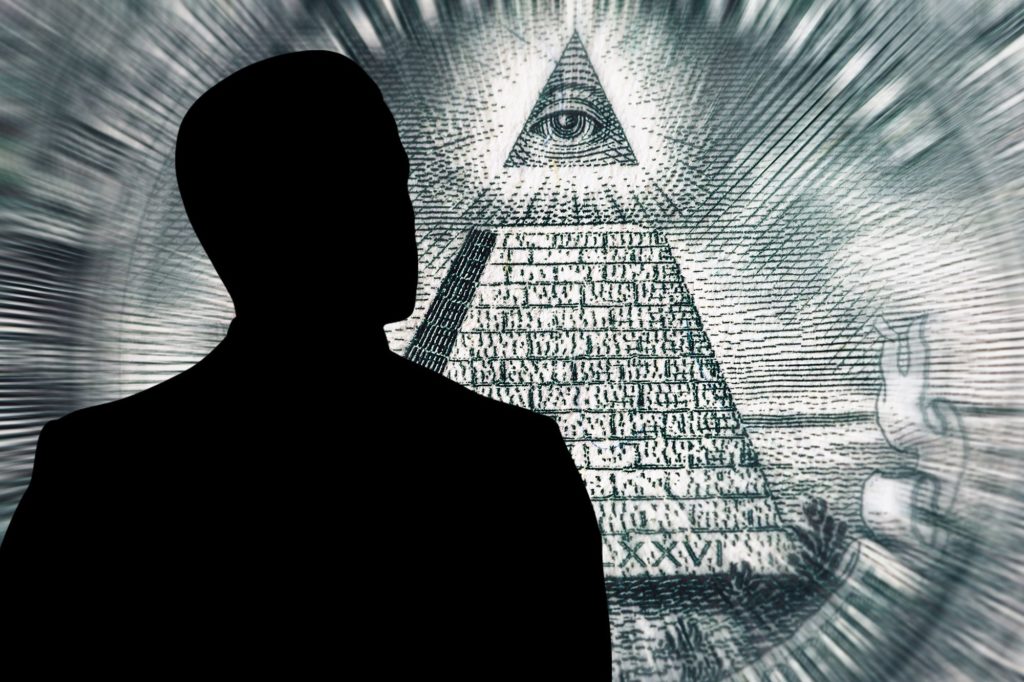


Online Islamophobia remains an ingrained issue when it comes to tackling hate in the UK. The police recorded 89 online anti-Muslim hate crimes in 2018, while monitoring group Tell MAMA recorded 327 verified online anti-Muslim incidents in 2018, down 10% from 2017, though still five percent up compared to 2016 figures. Explaining the discrepancy with police figures, Tell MAMA noted that as it was “primarily a victim support agency” it “more often deal(s) with cases of discrimination, hate speech, and anti-Muslim literature than the police, as these may not warrant criminal convictions”. (The Home Office October 2019 hate crime report also highlighted that police statistics on online offences were “likely to have been an underestimate”.) Such breadth is highlighted below, where we examine the spread of violent anti-Muslim ideas and disinformation, as well as the online ecosystems in which these grow.
Official figures for 2019 are currently unavailable, but Tell MAMA recorded a spike of almost 593% in the UK following the Christchurch terror attack, which included online threats to Muslims made in relation to the attack.
Christchurch underlined how interconnected online and offline anti-Muslim hatred is today; indeed, it emphasised the need for recognising the increasing porousness of the online/offline distinction. Reviewing the attacker’s manifesto, HOPE not hate’s Patrik Hermansson noted that following the attack the numerous ideologies referenced and language used indicate clearly that the attacker had developed his world view online. The attacker wrote that “you will not find the truth anywhere else” other than the internet. Furthermore, as Patrik commented, it’s important to understand that far-right terror doesn’t end when the last bullet has been fired. The ensuing media coverage and virally-replicated memes are often part of a perpetrator’s plan to sow division and hatred. Such intention also appears to arise in efforts to radicalise. Patrik highlighted that along with the manifesto, the far-right keywords graffitied onto the killer’s weapons functioned as gateways to extreme online environments, able to be picked up by viewers in the livestream of the attack.
Christchurch also typified the densely transnational nature of online Islamophobia and hate more generally today. As Tell MAMA noted in their report: “Although we verify reports of online anti-Muslim hatred to ensure only those based in the UK are recorded in our research, globally trending debates and news stories can motivate and spark trends in anti-Muslim rhetoric”.
Research from Cardiff University’s HateLab published in July 2019 broke ground on developing an understanding of these trends. It indicated “a consistent positive association between Twitter hate speech targeting race and religion and offline racially and religiously aggravated offences in London,” suggesting that “online hate victimisation is part of a wider process of harm that can begin on social media and then migrate to the physical world.”
Transnational interaction continues to play a role in the spreading of Islamophobia online more generally, beyond the extremes detailed above. Online forums and image boards populated by the international far right coordinate Islamophobic social media campaigns and spread wholly fabricated messages across social media.
One example highlighted from HOPE not hate’s research regards the image of a woman in a headscarf on the day of the Westminster attack, in March 2017. The picture shows a Muslim woman walking with a phone in her hand, past a group of people aiding one of the other victims of the attack. It gained significant attention after a Twitter user called @Southlonestar claimed that the woman was indifferent to the suffering of others and that this was generally true for all Muslims. That the woman was indifferent was not true (this has been refuted by both the photographer and the woman herself). Other pictures in the series show her noticeably distraught by what she has just witnessed.

In fact, @Southlonestar was one of the approximately 2,700 accounts that Twitter identified as being part of a Russian-sponsored influence operation in November 2017. Along with spreading Islamophobic hate, it also spread messages before the US presidential election and was one of the accounts that tweeted pro-Brexit messages on the day of the EU referendum in June 2016. Regardless of the circumstances behind the picture, it was quickly shared by several major far-right and Islamophobic accounts on Twitter, including those of alt-right leader Richard Spencer and Islamophobe Pamela Geller.
However, this image of the Muslim woman would soon be used for even more nefarious purposes. The same evening it was shared, the picture was appropriated by users on the /pol/ board on the online forum 4chan. One user posted a picture where the woman was superimposed into another setting, with the simple comment next to it “you know what to do”, meaning that he wanted his fellow users to create images superimposing the woman into other settings.

In the comments that followed were hundreds of variations of the posted image, most situating the woman next to various kinds of atrocities. Clearly inspired by the original post or its derivatives, the pictures aimed to send the message that the woman (and Muslims overall) were unmoved by the suffering of others – or even enjoyed it. Many of the doctored images were extreme and obvious parodies and did not leave the forum. In one she is seen walking past what looks like a Nazi extermination camp in Germany. However, importantly some did not stay on 4chan. Two weeks later a manipulated image was spread on social media in Sweden, after four people were murdered by a car in a terrorist attack in Stockholm. The image showed a paramedic walking between what looked like covered bodies while in the background the familiar silhouette of the woman on Westminster has also highlighted how Facebook’s communal and private dimensions are playing a role in catalysing Islamophobia and hate more broadly.
Facebook groups in particular are built such that they can lead to both a widening and a deepening of an individual’s prejudiced politics through content shared by other members within that group (so too on pages). Far-right activists have, in other online contexts, actively attempted to lead individuals they perceive to be susceptible to far-right ideas into the movement or encouraged people who are engaged in more mainstream or moderate far-right politics to take up more extreme positions. One example is the case of the commenting platform Disqus, which provides comment functionality to many large news sites. There have been coordinated attempts by far-right activists to engage in comments fields on mainstream news sites and alternative news outlets such as Breitbart News as a way to propagate far-right ideas to the readership of these sites.
Far-right users accessed articles and engaged in conversations in the comments fields in order to link to more extreme positions related to the topic of the article or use it to argue for other far-right positions. The goal was to take those who agree with more mainstream far-right ideas or have specific grievances around, for example, immigration and move them deeper into the far right or add more extreme interpretations of a certain issue. The tactic could, for example, be used to connect issues like immigration to antisemitic and anti-Muslim conspiratorial ideas.
The danger of this practice is that when an individual joins a Facebook group reflecting a specific interest or anger that they have, they can be set on a path to consume wider far-right material they otherwise would not have come across. Single issue engagement towards, for example, the construction of a new mosque in their area, can via Facebook groups introduce them to other Islamophobic ideas, and wider far-right propaganda on other topics. This can contribute to the adoption of more extreme views and broaden their prejudice from a single issue or few issues to a more fully formed far-right worldview. Importantly, in the case of Facebook groups, the effect of being introduced to new far-right positions needs to be seen in the context of the relationship between members in a group. That they have joined a group, sometimes a relatively small one, generally indicates a level of support for similar ideas. As such, there is a risk that a perceived sense of commonality and agreement can make members more trusting and receptive towards content posted by other members in the group. This could further exacerbate the risk of the broadening and/or deepening of their far-right engagement.
Illustrative of this is Yellow Vests UK, a closed group which presents itself as a British counterpart to the original French Gilets Jaunes. It has approximately 1,400 members at the time of writing. Like the original movement, at least superficially, the group is centered on anti-government and populist sentiments about the UK government not representing the “will of the people” and that it has “contempt for the working class.” A vast majority of posts in the group reflect a feeling of betrayal from UK politicians towards the electorate and highlight the incompetency as well as supposed corruption of UK politicians and especially, though not exclusively, the Labour Party. Content about British people not getting the support they need from the social security system are also common and similarly used to highlight the failure of the state. Smaller topics include occasional anti-immigration posts and posts romanticising British history, such as quotes by Winston Churchill and references to the Magna Carta. Despite this, following its creation in December 2018, the group has exhibited frequent Islamophobia, often demonstrating a slide into more explicitly racial nationalist politics. A user in May 2019, for example, posted the following making reference to the ‘indigenous British’:

And replies included a further change of language to “white British”:

The group has also seen a broadening of far-right views, from anti-LGBT+ views to posts about the ‘Kalergi Plan’ far-right conspiracy theory. This alleges that there is a deliberate plan to undermine white European society by a campaign of mass immigration, integration and miscegenation conducted by sinister (and often Jewish) elites.
The above areas of developing online Islamophobia in the UK (and internationally) do not always occur in isolation. Illustrating misinforming through images and the dynamics of Facebook groups, is an example similar to that given above of the woman passing the site of the London Bridge terror attacks. The use of photos stripped of context to incite anger and hatred against Muslims can be seen in Facebook groups that do not have Islamophobia as their apparent purpose. In the ‘Jacob Rees-Mogg: Supporters’ Group’, a public Facebook group with over 24,000 members that was ostensibly set up to promote the Conservative MP, a photo of Muslims praying in the road on London Bridge was posted with a caption that implied the men were choosing to pray illegally in the middle of a road and stopping traffic by doing so.
The post prompted an avalanche of vicious rhetoric from the group’s members, including dozens of violent fantasies of running the men over, spraying them with pig faeces or throwing them off the bridge. Even if it were true that the men were illegally blocking a road for their prayers, this level of vitriol would be extreme. Yet the missing context – perhaps deliberately obscured by the persons sharing the image – was that the road had already been closed by a minicab drivers strike. Both lanes were blocked by minicab drivers – of every religion and none – who had parked up their cars in protest against the congestion charge. Those drivers who happened to be Muslim were simply observing their prayers while doing so.

As with the Gilets Jaunes group, there are many reasons that someone might choose to join the ‘Jacob Rees-Mogg: Supporters’ Group’ – support for his stance on Brexit, admiration for his character, or out of curiosity. But the lax moderation policy of the group’s admins – some of whom have posted anti-Muslim material themselves – means that whatever their initial reasons for joining the group, they will subsequently be exposed to fake news, conspiracy theories and violently anti-Muslim rhetoric. Those who are strongly opposed to bigotry might immediately choose to leave the group, but those whose views on diversity and equality are less certain will find a steady drip-feed of weaponised far-right propaganda in their Facebook newsfeed from that point onwards. The effects of such exposure are hard to measure, but it is something that social media companies must urgently consider when evaluating their impact on our communities. With means of propagating Islamophobia online continuing to coalesce in online spaces in the UK and abroad, we must work harder to stem its spread.
WARNING: THIS ARTICLE CONTAINS SOME EXTREMELY OFFENSIVE/UPSETTING CONTENT
In January this year, there was a liberal outcry in the UK after the non-violent environmentalist group Extinction Rebellion appeared on a watch-list compiled by counter-terror police. Titled Safeguarding young people and adults from ideological extremism, the 12-page document, produced by officials in the south-east, listed a variety of ideologies deemed dangerous enough to warrant reporting an individual to the Government’s Prevent safeguarding programme. While Extinction Rebellion made the list, one group that did not was the Order of Nine Angles (O9A/ONA), a UK-originating Nazi-Satanist cult that has openly promoted extreme violence for decades, and has influenced terroristic nazi groups on both sides of the Atlantic. Despite its distinctive terminology and iconography, the availability of its published works, its understood goals, strategies and tactics and its documented impact on the extreme fringes, O9A continues to fly under the police radar, who appear too bewildered by the group to understand its threat and take action.
While it claims to have pre-Christian roots, O9A’s modern iteration originated in the early 1970s, when British nazi David Myatt, using the alias Anton Long, developed a system that intertwined elements of Satanism, paganism and Nazism into a bizarre pseudo-religious political cult. In brief, O9A seeks to harness supernatural forces and overthrow the alleged “Nazarene/Magian” (Jewish) influence on society, reduce the population of “mundanes” through acts of extreme barbarism, and usher in a new imperial aeon (age) ruled by a race of Satanic supermen who would colonise the solar system.
Such notions are patently absurd, but as Jacob C. Senholt of the University of Aarhus claims, unlike many Satanic creeds, O9A is inherently intertwined with extreme politics, and is bent on subverting and destabilising society through both “magick” and practical action.
There is a deeply transgressive spirit and a very real cruelty at the core of O9A, which encourages acolytes to engage in forbidden and illegal acts, including extreme violence, sexual assault, assassinations and human sacrifices (or “culling”). Doing so supposedly enables contact with sinister supernatural forces, and accelerates the breakdown of the current system. In The Dreccian Way, leading O9A figure Richard Moult (AKA Christos Beest) writes: “To cull humans is to be the ONA.”
O9A is organised into “nexions” (chapters), and climbing O9A’s hierarchy requires founding and leading one’s own nexion. Groups resembling O9A are known to have been founded in mainland Europe, the US and New Zealand, but as Senholt writes, it is difficult to ascertain which of these groups “are merely inspired by O9A, sharing their ethos, and which groups are a direct result of an initiate’s work within the order”.
The group’s hierarchy also requires followers to undertake “insight roles”, which means spending a minimum of six months infiltrating and subverting other organisations or religions in order to gain new experience, thereby strengthening O9A. The O9A work Hostia directs initiates to: “Undertake the role of extreme political activist and so champion heretical views (by e.g. becoming involved in extreme Right- Wing activism)”, or alternatively to join the police.
Myatt, who regards Nazi Germany to be “a practical expression of Satanic spirit”, has been actively involved in extreme right politics for decades. In the 1990s he contributed to the emergence of a militant far-right underground in the UK. He was a particular influence on the Sargent wing of the nazi terror group Combat 18, and also founded the National Socialist Movement, which counted the 1999 London nailbomber David Copeland among its members.
When asked in 2005 if O9A was posing as nazis to recruit and spread its message, Myatt responded:
“You seem to have missed the point about O9A and National Socialism. From the get-go the O9A have propagated holocaust revisionism, have praised Hitler, have encouraged members to join NS groups, with one of their core principles being, to quote Professor Monette, ‘the Way of Defiance of and Practical Opposition to Magian Abstractions’. This principle refers to the O9A’s opposition to what it perceives as illegitimate Magian (western Judaeo-Christian) control of global culture and economics.
Magian is O9A code for ZOG [Zionist Occupation Government – a phrase to describe the Jewish control of the state that became widely adopted by nazis in the 1980s and 90s].
For Myatt, a National Socialist society can only be achieved by revolution: “Revolution means struggle: it means war. It means certain tactics have to be employed, and a great revolutionary movement organised which is primarily composed of those prepared to fight, prepared to get their hands dirty and perhaps spill some blood.”
In 1998, Myatt wrote A Practical Guide to The Strategy and Tactics of Revolution, widely considered his terrorist manifesto.
Myatt converted to fundamentalist Islam, initially as an attempt to unite jihadists and nazis over their mutual hatred of Jews, but when that failed he threw himself into hard-line Islamism. He became a strong supporter of Hamas and al- Qaeda, writing long diatribes in support of terrorism and suicide attacks.
Whether Myatt had genuinely converted is open to question, but given his life and the O9A rules, his promotion of Islamism is just as likely to have been another period of “insight” rather than a true conversion.
Given its clandestine and decentralised nature, it is difficult to estimate O9A’s true size and influence with confidence. Some believe it’s comprised of just a handful of people, while others put its global membership at 2,000. Whatever the true figure, what is abundantly clear is that O9A has enjoyed a recent resurgence among several of both the USA’s and UK’s most extreme terroristic far-right groups, and has gained a new visibility online. Most disturbingly, the adoption of O9A’s philosophy of unbridled transgression and depravity appears to have played a role in excusing, or even fostering, a culture of violent sexual sadism and the promotion of weaponised rape among certain sections of the extreme right. O9A operates on two levels. It sends its supporters into existing organisations to influence and recruit, but it also disseminates its propaganda far and wide, both through its own platforms and those of others. O9A functions both as a covert organisation, and as a brand suited to the online post-organisational far right: young radicals drawn to extreme fringe ideas can easily access O9A material and take from it what they wish.
Ryan Fleming was a prominent activist within the now-banned British terrorist group National Action (NA). He got involved in NA in February 2015 after he made contact through the now-defunct nazi forum Iron March (IM), offering his services as a cybersecurity expert. His first public appearance for NA was on its Newcastle demo, where he made a hard-line barnstorming speech, described by soon-to-be terrorist Jack Renshaw as “great bants”.
What his new NA friends did not know was that Fleming was an important figure in O9A, running its Yorkshire nexion, and was closely linked to its offshoot in the US, the ‘Tempel ov Blood’ (ToB).
Fleming was also an established writer on the occult and Satanist scene, writing several books under the pseudonym A. A. Morain. Among his masterpieces were Scithain: Vampyric Witchcraft of the Drakon Covenant and Codex Aristarchus, with the latter having a foreword written by Czar Azag-kala of ToB. Fleming’s books focus on hunting down people in rural settings and feeding on them.
In 2011, Fleming was jailed for the sexual assault of a vulnerable young man, who he had imprisoned and tortured before forcing him to perform a sex act. This was not considered serious enough to have him excluded from NA. In 2017, after NA was banned, he was jailed for sexually abusing a 14-year-old girl.
It would also appear that West Yorkshire Police was either totally unaware of Fleming’s involvement in O9A, or did not think it was in anyway related to his politics. This meant that they ignored a possible Satanic/political element to his abuse, as well as the impact his views were having on others.
Through Iron March, which did much to develop the modern terrorist nazi scene, Fleming guided interested users to O9A texts in private messages. His profile on the forum was chilling: “The best political weapon is the weapon of terror. Cruelty commands respect. Men may hate us. But, we don’t ask for their love; only for their fear.” Any knowledge of his involvement in O9A should have made the authorities far more concerned with statements like these.
We will probably never know how effective Fleming was in spreading his Satanism, but what we do know is that others within the NA orbit began dabbling in O9A.
When police raided Garron Helm for alleged membership of NA in September 2017, they should have noticed the framed O9A picture hanging above the mantelpiece in his living room. Likewise, they should also have realised that the picture stuck onto the notebook of Andrew Clarke, another former NA activist arrested at the same time, was the logo of O9A.
Helm became a strong believer, and described his participation in Prevent, the government’s deradicalisation programme, as “insight”. He is now rumoured to have begun recruiting for his own nexion in the North West.
More widely reported is O9A’s influence on the Atomwaffen Division (AWD), a US-based group that grew from Iron March in 2015, in part inspired by NA. The group aims to establish a network of leaderless cells in order to wage a brutal terrorist war and overthrow the system. Journalist Jake Hanrahan and ProPublica, who have done much to expose the leadership, organisation and ideology of AWD, estimated in February 2018 that the group had established as many as 20 cells across the US. However, since being linked to five murders, it has suffered crackdowns and numerous arrests.
AWD has also suffered deep internal rifts due to the increasing influence of O9A and ToB, a development that emerged after John Cameron Denton (AKA “Rape”) took control of the group. AWD has increasingly incorporated Satanic iconography into its propaganda, including images of Myatt, and also promoted O9A and ToB literature on its website. Its endorsement of books such as Liber 333 and especially Iron Gates, a horrific fiction that graphically depicts the murder of a child in its opening pages, has proved particularly divisive, with several AWD members quitting in protest in 2018.
Since then, ToB Satanists have reportedly strengthened their hold on AWD’s leadership. Journalist Nate Thayer reported last year that leading AWD activist Corwyn Storm Carver had posted pictures of himself posing with O9A literature while deployed in Kuwait with the US military, alongside the caption “Hidden in plain sight. #O9A #orderofnineangles #hostia #knowledge #esoteric #military #soldier”.
While it would appear that O9A got involved in National Action either as ‘insight’ or to recruit, a much stronger link existed with the Sonnenkrieg Division (SKD). SKD emerged as a split from within System Resistance Network (itself an NA splinter group), after several members were expelled due to their preoccupation with O9A. Members of the small group, which described itself as an “offshoot” of AWD, celebrated rape, paedophilia and murder, and, like Fleming, were fixated on the Moors murderers.
In June 2019, SKD members Michal Szewczuk, 19, and Oskar Dunn-Koczorowski, 18 (previously a member of NA), received four years and 18 months, respectively, for terror-related offences. Szewczuk ran a blog that encouraged the rape and torture of opponents, including small children, and Dunn-Koczorowski wrote about decapitating babies.
In September 2019 Jacek Tchorzewski, 18, who had links to SKD, received jail time for possessing bombmaking manuals and instructions on how to make firearms. He was also found to have Satanist literature depicting rape and paedophilia at his house. Disturbing images of the apparent rape of a woman, who had a swastika cut into her flesh, were also circulated by another alleged member of the group.
HOPE not hate is aware of several other SKD activists linked to the O9A.
Recently, a nazi who was just 16 at the time of his arrest, became the youngest person ever convicted for planning a terror attack in the UK, and was jailed for six years and eight months. He was obsessed with Satanism, etching the O9A symbol into his revolting terror manual.
“I believe there is primal enjoyment to be had in sadism,” he wrote. “How wonderful it is to be an amoral individual”.
The threat of O9A also manifests through the propaganda spread by its supporters. The internet, and particularly the encrypted platforms increasingly used by violent nazis, are awash with O9A and ToB material. Some such material focuses on pure nazism, while others gleefully promote sexual violence. This is especially the case across the so-called Terrorgram network on the messaging app Telegram, which is detailed elsewhere in this report.
There are several small dedicated O9A channels and groups on Telegram, spaces where PDF files of O9A/ToB texts and music are shared, and occult propaganda, sometimes featuring Myatt’s face, is posted. The relatively large channel “RapeWaffen”, which claims to have splintered from AWD, states that its “official beliefs are o9a Satanism and Esoteric Rapistism”, encouraging followers to “JOIN YOUR LOCAL NEXION”.
What is most disconcerting is that O9A material has become so commonplace and normalised that it is even accepted by those who do not actually share in its Satanism. HOPE not hate knows of one person, currently awaiting trial on a terrorism charge, who shared O9A material while stressing that he did not actually agree with it all.
“I am not into O9A, I’ve read into their stuff […] it isn’t mind blowing stuff”, he wrote, yet he regularly used O9A symbols in his artwork, thereby extending its spread.
Many people understandably find it difficult to discern the extent to which support for O9A/ToB is sincere, as its terminology and trappings have taken on lives of their own, adopted into the lexicon of the wider terroristic far right. Embossing propaganda and weapons-making manuals with Satanic symbols provides them with a sheen of occult mystery, and the sheer notoriety of O9A means that references to it function as shorthands for extremism and violence.
O9A continues to be a divisive force on the extreme right, and the proliferation of its ideas and imagery on platforms such as Telegram is much to the dismay of other nazis. One far-right channel exists solely to “expose” O9A Satanism on Telegram, considering Satanists to be violating the purity of National Socialism, degrading it into “utter hopelessness, nihilism and pointless hatred”. This only intensifies the allure for some; O9A is enticing to certain individuals precisely because it frightens, and holds status as the “edgiest” set of beliefs available. But given the history and writings of Myatt and others, O9A’s links to people connected to terrorism in the UK, and the violence of groups linked to it in the US, we have to take O9A seriously.
In the post-organisational far right, where young people are increasingly radicalised online and getting drawn into the occult, the allure of the O9A is growing. For an organisation that spent decades on the fringes of the fringe, its propaganda and message has become more widely distributed than ever before.
O9A’s sick ideas have drawn in young extremists in the UK and elsewhere, and have helped nourish a dangerous culture of unprecedented depravity amongst the extreme right, which has none of the moral constraints that previous generations of far-right activists had.
Reflecting on 40 years of political activity, Myatt said in a 2005 interview with Aryan Nations: “In my own life, I have tried to create some things which can disrupt our societies and which can lead to the creation of strong, really dangerous, ruthless individuals – some things which are so subversive that no laws could ever outlaw them, and that attempts to restrain them, to outlaw them, would only make them more attractive to some individuals.”
2019 saw a fresh and ferocious kind of far-right violence emerge in Western countries. In March, a 28-year-old Australian attacked two mosques, murdering 51 in Christchurch, New Zealand. In April, a teenager in Poway, California, gunned down a woman and injured three others in a synagogue. In August, a 21-year-old massacred 22 in an anti-Latino spree in a Walmart store in El Paso, Texas. In October, an armed 27-year-old man in Halle, Germany, tried and failed to force his way into a synagogue on the Jewish holiday of Yom Kippur, instead executing a passer-by and a staff member in a nearby kebab shop.
All four killers released manifestos heavy with slang and in-group references, and the Christchurch and Halle attackers livestreamed their actions online. While they were not known “members” of any formal organisations, all four made clear that they viewed their actions not as isolated incidents, but as part of a wider offensive, drawing inspiration from previous attackers and detailing their motivations and methods in the hope of sparking further rampage.
Over the past two years, we have also witnessed small, decentralised, international and terroristic extreme-right “groups” announcing themselves online. While these secretive and fragmented networks may differ politically in some aspects, they all draw inspiration from existing far-right terror networks, such as the Atomwaffen Division (AWD), and similarly preach a message of sabotage and guerrilla warfare in order to accelerate the collapse of the “system”, thereby unleashing a carnival of homicide in which their perceived enemies will be annihilated.
What connects these two phenomena is a bloodthirsty far-right ecosystem that has taken root in recent years, suppurating on anonymous imageboards, public channels, private forums and messaging apps. This subculture cheerleads for and deifies terrorists, and regards mass murder not only as a means to revolution and retribution, but as a form of entertainment. It was the audience to which these gunmen addressed their sprees, and enables budding far-right activists to radicalise and network, and allows new groupings to coalesce.
If we are to understand the nature of contemporary far-right terrorism, it is imperative that we navigate this complex, labyrinthine and hard-to-monitor world of pro-terrorism online spaces. In particular, we must explore the so-called “Terrorgram” network, a collection of a few dozen public channels and private chat groups on the messaging app Telegram, which is developing into a central hub through which this subculture operates.

While pro-terror content is accessible on almost any social media platform, many of the major firms have become more proactive in tackling the issue since the far-right rally in Charlottesville, USA, in August 2017, when a neo-nazi drove his car into a crowd and killed a counter-protester, Heather Heyer. This more proactive approach from social media firms is of course welcome. But one consequence is that deplatformed groups and individuals have re-congregated on platforms with a more laissez faire attitude towards extremism. Since its foundation, the encyrpted messaging app Telegram has placed an overriding emphasis on privacy; founder Pavel Durov once claimed that “our right for privacy is more important than our fear of bad things happening, like terrorism.”
The platform, which now has hundreds of millions of active users across the globe, has long been central to the operations of jihadi groups, most notably supporters of the so-called Islamic State (IS). A 2017 report by the Counter Extremism Project showed how extremist groups used the platform “to recruit new members, fundraise, incite to violence, and even coordinate terrorist activity.” Elements of the far right have also made Telegram home, increasingly since the Christchurch attack. The SITE Intelligence Group reported that almost 80% of a select sample of 374 far-right Telegram channels and groups were created between the 15 March massacre and 30 October.
After years of inaction, Telegram finally began purging accounts associated with IS and al-Qaeda in November 2019. However, as terrorism analyst Rita Katz has highlighted, the platform has yet to do the same for the multitude of public nazi channels, private groups and accounts, despite many being just as threatening as jihadists.
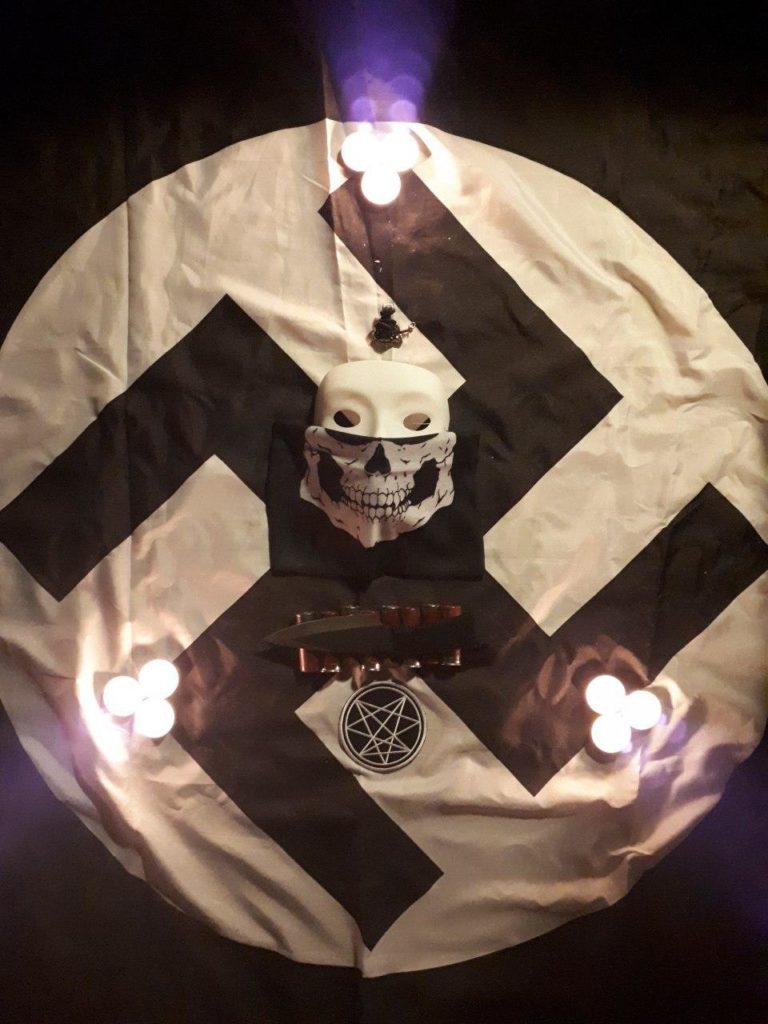
Telegram’s stance is particularly concerning given the stark extremeness of Terrorgram channels, which prolifically spew out white supremacist propaganda, snuff videos of lynches and shootings, survivalist and guerrilla training manuals, and instructions for manufacturing weapons, carrying out attacks and evading detection.
Most channels are in English or Ukrainian, although German and Spanish channels also exist; many of those in English appear to be US-oriented, although a handful are known to be UK-based. While some channels are dedicated to specific extreme-right organisations and others to obscure variants of far- right terrorism, the most popular take a more broad approach and serve as feeds for all types of far-right, pro-terror content, heavily recycling posts from, and actively promoting, other Terrorgram channels.
It’s possible to assume a large amount of crossover in followers across Terrorgram channels and groups. The biggest have accrued over 4,000 followers in under a year – significant numbers for outlets urging viewers to “Piss away any morals you have left” and take up arms.
A major preoccupation of Terrorgram is the worship of terrorists, who are canonized as “Saints”. Most of their pantheon consists of white supremacists, including the 1999 London nailbomber David Copeland and the perpetrator of the 2011 Norway attacks, Anders Breivik. A surprisingly diverse range of other killers are praised and discussed on Terrorgram, often used as case studies from which potential attackers can learn. For example, Islamist terrorist Omar Mateen has been dubbed a “hero” for murdering 49 people at a gay nightclub in Florida in 2016, and Christopher Dorner, an African American, has been celebrated for his nine- day 2013 campaign of warfare against police.
The Provisional IRA is often glorified for its longevity, tactical sophistication and aesthetics. Even the Zodiac serial killer, who murdered at least five people in the 1960s and 1970s, has been praised for his ability to evade capture, and Jim Jones, the cult leader who led over 900 to mass suicide, was included in a “leader board” of “Saints” for the sheer numbers he took to the grave.
The celebration of such figures reveals the bleak nihilism underpinning Terrorgram; for many the capacity for death is the highest virtue, and political or religious alignment is secondary.
Of course, the modern terroristic nazi scene predates Terrorgram. One major influence is the now-defunct nazi forum Iron March (IM), linked to both the proscribed UK-based nazi terror group National Action (NA), and the US-founded Atomwaffen Division (AWD). Despite having little over 1,200 users when it folded in November 2017, as a forum Iron March has had an outsized influence on modern nazism. In particular, it popularised SIEGE by veteran American nazi James Mason, a work promoting the establishment of underground, leaderless terrorist cells, working towards destabilising society and ushering in revolution.
Iron March was also key in the development of the “terrorwave” aesthetic, a distinctive and deeply menacing form of visual propaganda that succinctly communicates a message of terrorist violence. Usually rendered in red, white and black, the style often incorporates images of historical fascists, terrorists or paramilitaries wearing skull masks, alongside esoteric far-right symbols and simplistic slogans (such as “TRAITORS WILL HANG” and “RAPE THE POLICE”).
The influence of IM on Terrorgram is profound, and the philosophies of SIEGE and the terrorwave aesthetic are ubiquitous across Terrorgram channels.
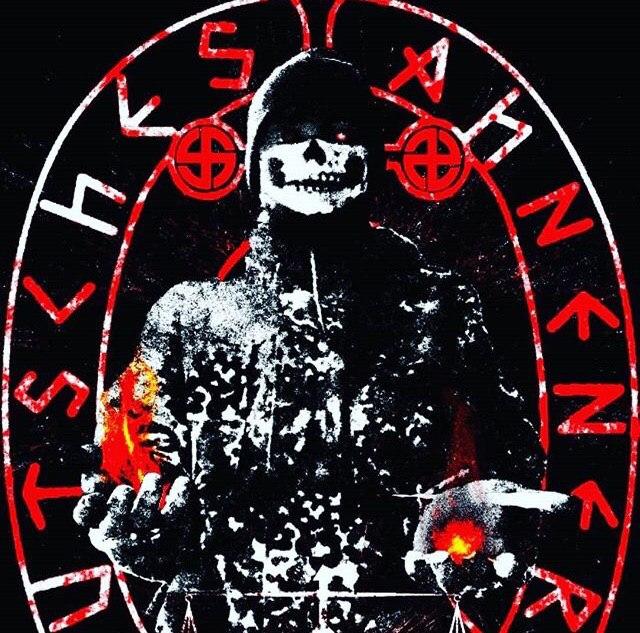
While all are unequivocally dedicated to decentralised terrorism, there is a degree of ideological variation within the Terrorgram circuit. There are several channels dedicated to “eco-fascism”, for example: a loose and intensely antisemitic far-right scene that emphasises a mystical connection to the land, the violent enforcement of animal rights, and often genocidal solutions to the issue of overpopulation.
The scene became increasingly visible during 2019, in part due to the Christchurch killer self-identifying as an eco-fascist, and the El Paso killer using eco-fascist arguments in his manifesto.
There is also a strong strain of esotericism and occultism woven into Terrorgram propaganda, lending a mystic sheen to the movement. Esoteric Hitlerism is frequently referenced, a bizarre pseudo-religion cooked up post-war by Nazi zealot Savitri Devi, who co-opted elements of Hinduism and alleged that Hitler was an incarnation of the god Vishnu.
The iconography of the Order of Nine Angles (O9A), a neo-nazi Satanist group, also often appears on Terrorgram. Founded in the UK in the 1960s, O9A combines Hitler worship with occultist trappings, and encourages adherents to commit violence, rapes and even the “culling” of human victims in order to undermine civilisation. A key acolyte was David Myatt, a man who influenced both the nazi terror group Combat 18 and the London nailbomber David Copeland in the 1990s, before converting to fundamentalist Islam and spending over a decade promoting al-Qaeda.
While it is unlikely many Terrorgram users genuinely believe the teachings of Devi and Myatt, the sheer extremeness of their philosophies are alluring to young activists in search of the “edgiest” positions available, and fluency in the wilfully baffling jargon and occult symbolism are used to signal in-group status. As we report elsewhere in State of Hate, O9A has experienced a resurgence in recent years, with members of NA and AWD dabbling in its ideas. It is also believed to have been influential on the Sonnenkrieg Division (SKD), an offshoot of NA, which has produced some of the most sickening and degraded content ever produced by the British far right.
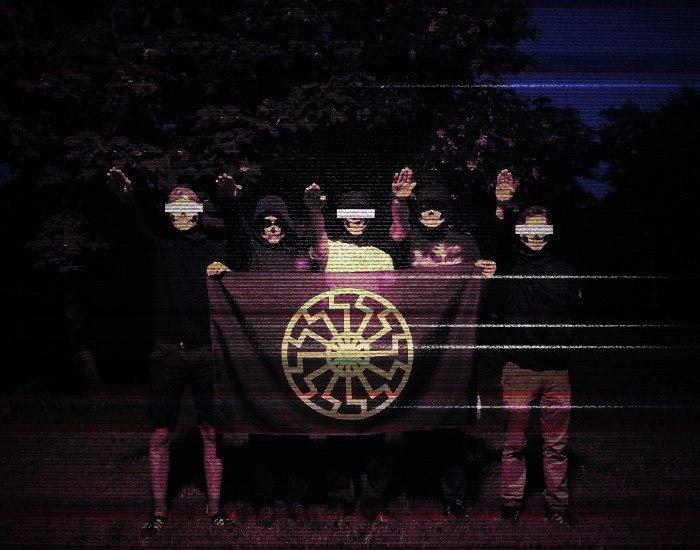
Most worryingly, Telegram has extended the reach of an array of international terroristic organisations, some of which continue to announce new cells in Europe, Australasia and North America. The platform has also played midwife to several new terroristic groups over the past year, some of which, although small, are establishing cells offline, committing hate crimes and threatening public officials.
AWD remains a looming presence on Terrorgram. Founded by IM users in 2015, the group was the first of a new generation of nazis to embrace the philosophies of SIEGE, and has been linked to five murders in the US. Whilst it has suffered crackdowns and numerous arrests in recent years, cells outside of the USA continue to broadcast its message.
In October, a pre-existing Telegram channel with thousands of followers announced itself “the official channel for THE ATOMWAFFEN DIVISION”. The same day it claimed that “in the past months the AWD have received hundreds of emails with positive feedback and key cells across the globe have been established within such a short time”, posting a video of heavily-armed activists from its recently formed Ukrainian branch.
AWD in turn has influenced The Base, another key name on the Terrorgram circuit. Formed in July 2018 and taking its name from al-Qaeda, the “Siegepilled” (SIEGE-promoting) group held paramilitary training camps in the USA during 2019. The group has had a disastrous start to 2020, with six members arrested in the USA for various charges including conspiracy to murder an anti-fascist couple, and The Guardian revealed that Rinaldo Nazzaro, an American living in Russia, was the mastermind behind its operations. It is unlikely that the group will survive, although its legacy will continue to resound on Terrorgram.
Also notable is the emergence of the Feuerkrieg Division (FKD). Established in late 2018, FKD is believed to have fewer than 50 members, primarily based in Europe, including the UK, the Netherlands and Estonia, and has recruited activists in Canada and the USA.
In August last year, an alleged FKD activist was arrested in Las Vegas for allegedly plotting antisemitic and homophobic attacks, with bomb-making materials found in his home. Following the September arrest of an alleged teenage member, the group also received press coverage in the UK after it posted a picture on Telegram of the Chief Constable of West Midlands Police with a gun to his head. Another post bore the words “Release our member or your heads will be our agenda”, alongside the addresses of police stations and offices.
Smaller, more recently formed groups include the eco-fascist outfit The Green Brigade (GB), which launched on Telegram in November 2019 and quickly accrued over 1,000 followers. Describing itself as “an organization consisting of openly accelerationist, militant environmentalist members focused on tearing down the system that exploits our people, land and animals”, activists have distributed posters in Arkansas and New Hampshire in the USA, Stockholm in Sweden, and London and Scotland, UK.
VICE magazine has linked GB to an arson attack on a mink farm in Sölvesborg, Sweden, and labelled it “a cell within The Base”, although GB claims it has “no formal agreements with any other group and it will remain that way”.
The Vorherrschaft Division (VSD), established in August 2019, is yet another pro- SIEGE group. Although undoubtedly tiny, in October last year a synagogue in Michigan was plastered with VSD posters featuring images of Hitler with the words: “Did you forget about me?” VSD’s Telegram channel has also published the detailed personal details of the families of perceived enemies, including children, and encouraged readers to “pay them a visit”. The purpose of establishing these myriad outfits is decentralisation, ensuring that when a group becomes compromised (such as The Base), others are untarnished. The effect is also disorientating, inflating their scope and creating the illusion that there are nazi cells in every town poised for violence. While their Telegram channels may have hundreds of followers, in reality some of the smaller announced “groups” may at this stage consist of little more than a logo, a Telegram channel and an email address, and their “cells” being single activists.
However, to minimise the threat of far-right terrorism is both foolhardy and dangerous. As we have seen in Christchurch, Poway, El Paso and Halle, it only takes a single individual to carry out a deadly attack.
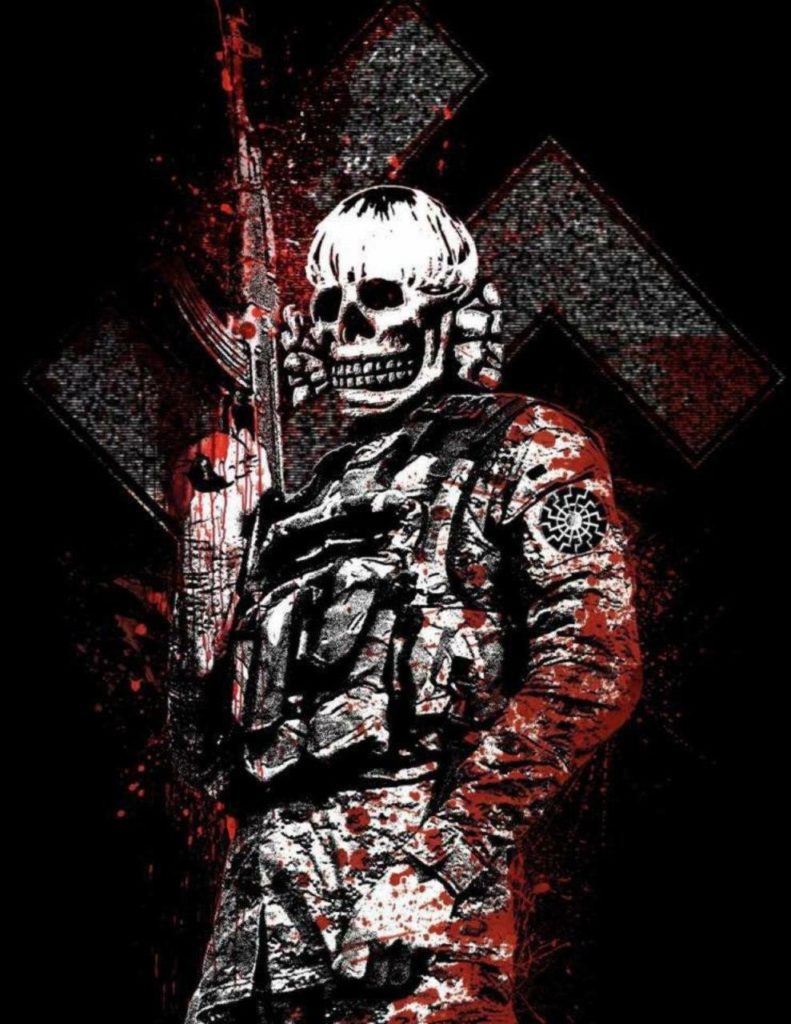
Telegram continues to fail to take action against the cruel subculture operating through its software, and must do much more to impede its spread. All tech companies have a responsibility to deal with the use of their platforms for nefarious purposes, and Telegram must be held to account.
It is crucial to recognise that Telegram is just one part of a wider underground ecosystem. Members of this system are conscious that they may soon be forced to find a new home online. As one popular channel posted: “This won’t last forever though, none of this stuff we’re doing on Telegram will. Eventually there will be a ban, a leak, an arrest, and we’ll have the option of finding our next Twitter/Discord/Telegram or we can begin to take things into our own hands.”
While Telegram bans alone will not eradicate the threat, it will take away one key means by which terrorists radicalise, propagandise and network. The platform must take action now, and we must track down potential terrorists wherever they run to next.
The relationship between the Jewish community and the Labour Party was in pretty dire straits at the start of 2019. The summer of 2018 had been dominated by a row over Labour’s eventual acceptance of the International Holocaust Remembrance Alliance (IHRA) definition of antisemitism, which occurred after the unprecedented ‘Enough is Enough’ rally led by Jewish community organisations in Parliament Square.
The year soon saw a stream of Labour Party members and candidates facing disciplinary processes for alleged antisemitism. In February, a row broke out between some members of the Parliamentary Labour Party (PLP) and Jennie Formby, the party’s general sectary after MPs Catherine McKinnell and Ruth Smeeth proposed a motion calling on the leadership to “adequately tackle cases of antisemitism”.
Other members of the PLP also accused Formby of covering up antisemitism over her refusal to release any data on disciplinary cases. A week later, the Labour Party released limited figures claiming that there were 673 cases of alleged antisemitism. The party had expelled 12 people to that date.

In March Jackie Walker was expelled more than two years after her original offending comments, including claims that Holocaust Memorial Day only commemorated Jewish victims. Leaks also showed that Jeremy Corbyn had involved himself in a disciplinary case and that his staff had asked to be copied into complaints, both of which had been denied by the Labour Party until this point.
In May, Pete Willsman was suspended for claiming that the Israeli embassy had organised a letter from 68 Rabbis in 2018, criticising Labour for changing the IHRA definition of antisemitism. In the summer, the Community Security Trust (CST) uncovered a network of Twitter accounts that had been at the centre of promoting a narrative about the weaponisation and denial of antisemitism in the Labour Party. These 36 accounts were part of a network that would run hashtag campaigns to target MPs and other leading figures who were speaking out against Labour antisemitism.
One particular account referenced was @socialistvoice, run by expelled member Scott Nelson, who regularly interacted with Holocaust deniers and neo-Nazis. Another was Heather Mendick, who was appointed by Jeremy Corbyn as Jewish Community Liaison Officer, an active supporter of then MP Chris Williamson and Pete Willsman.
Over the course of the year, many other candidates, councillors and activists were also caught up in antisemitism allegations. Multiple candidates were forced to resign, were suspended or became mired in controversy. For example, a senior councillor in Leicester was suspended for sharing content from David Duke, former grand wizard of the Ku Klux Klan. Three of Labour’s 16 candidates in Torbay’s local elections were suspended for posting content such as “New World Order Zionist Jews admitting they want to destroy every none [sic] Jew” and talking about “fifth columnists” in Labour. A council candidate in Manchester wrote in 2014 that seeing an Israeli flag made her feel sick, but was allowed to remain as a candidate and won her election.
After the General Election, these incidents continued, particularly with members blaming Zionists or media smears on Labour for the party’s defeat, and denying the problem of antisemitism had an impact in the election.
These issues have continued into the Labour Leadership Race. After the Board of Deputies released its 10 pledges for Labour leadership candidates, Rachael Cousins (the owner of the Rachael Swindon Twitter account) tweeted a list of demands to the Board of Deputies, including insisting the organisation should apologise for and condemn Israel, a common trope holding all Jews responsible for the Israeli government.
The relationship between the Labour Party and the Jewish Labour Movement (JLM), an affiliated socialist society of the party, is emblematic of the complete loss of trust between Jews and the party. JLM was instrumental in calling, and collating evidence, for the Equalities and Human Rights Commission (EHRC) inquiry into antisemitism in the party. After the resignation of Luciana Berger, its Parliamentary Chair, JLM debated disaffiliating from Labour. Although this didn’t happen, the movement passed a motion at its AGM saying that Labour was institutionally antisemitic and that it had no confidence in Jeremy Corbyn. Prior to this, Labour had scrapped the JLM training which had begun to be carried out in local part branches and at conferences. The relationship plunged to a new low at the start of the General Election, when JLM confirmed that it would only campaign “in exceptional circumstances” and instead campaigned solely for Ruth Smeeth, Margaret Hodge, Alex Sobel and Rosie Duffield.

The disgraced former MP for Derby North became a symbol of Jew-baiting and hatred, and caused an unnecessary saga that took far too long to resolve. Williamson came into 2019 still facing calls for the Labour whip to be suspended from him for sharing platforms with expelled members, denying antisemitism in the Labour Party and signing a petition in support of controversial jazz musician Gilad Atzmon.
Despite this, Jeremy Corbyn told Derbyshire Live: “Chris Williamson is a very good, very effective Labour MP. He’s a very strong anti-racist campaigner. He is not antisemitic in any way.”
Williamson further angered anti-racists in Labour by booking a room in Parliament to host a film screening in Parliament for then-suspended member Jackie Walker. In late February, footage was uncovered of Williamson saying that Labour was “too apologetic” over antisemitism. The party confirmed that he would be under investigation for a pattern of behaviour but would remain as an MP. However, after much anger from then-deputy leader Tom Watson, backbench MPs and a statement from HOPE not Hate, he was suspended.
Unfortunately, this did not prove to be the end of this sorry tale. In June, Williamson’s suspension was lifted by a three-person NEC panel and he was issued with a formal warning. It then took two days, and pressure from 120 MPs and peers, plus 70 Labour staff members, for his suspension to be reimposed. He unsuccessfully attempted to return as a Labour MP through the courts and after he was refused permission to stand as a Labour Party candidate in the General Election, he resigned from the party. He got his final kicking of the year at the ballot box, receiving just 635 votes and losing his deposit in Derby North. However, it should be remembered that his case was yet another that dragged out so long that Labour never had to take the final decision to expel him.
2019 saw the exodus of leading Labour figures who felt that the Labour Party could no longer find a way back to effectively fighting antisemitism, from Members of Parliament to key activists. In February, after years of fighting left wing antisemitism, from within student politics to amongst Labour members, and a fortnight after a proposed no confidence motion from Liverpool Wavertree CLP, Luciana Berger quit the Labour Party. She stated that she had become ‘embarrassed and ashamed to remain in the Labour Party,’ that the ‘leadership ha[d] wilfully and repeatedly failed to address hatred against Jewish people within its ranks’ and that she looked forward to ‘leaving behind a culture of bullying, bigotry and intimidation.’ Other MPs who left the Labour Party at a similar time also referred to Labour antisemitism in their resignations, including Mike Gapes, Ian Austin and Ann Coffey.
In October, Labour was faced with another resignation from a Jewish woman in a Liverpool constituency, with Dame Louise Ellman resigning two weeks after a no confidence motion was tabled against her in Liverpool Riverside CLP on Yom Kippur, the holiest day in the Jewish year. Dame Ellman said that ‘antisemitism had become mainstream in the Labour Party’ and that ‘the Labour Party is no longer a safe place for Jews and Jeremy Corbyn must bear the responsibility for this.’
In 2019, the Labour Party became the second ever political party after the British National Party to be investigated by the Equality and Human Rights Commission (EHRC), a body they set up whilst in government. The investigation was triggered by complaints made to the EHRC that led them to believe that Labour may have ‘unlawfully discriminated against people because of their ethnicity and religious beliefs.’ Due to the volume and severity of the complaints, the EHRC made this a full statutory investigation.
The Labour Party rejected that it acted unlawfully, but state they have fully cooperated with the investigation. The Jewish Labour Movement have been instrumental in coordinating testimonies from Labour members and non-members and whistleblowing statements from former and current staff that have been sent to the EHRC. Some of the whistleblowers took in a BBC Panorama documentary entitled ‘Is Labour AntiSemitic?’ which began to uncover the extent of the failures to deal with antisemitism and the political interference in the disciplinary processes.
Rather than setting to work to address the issues raised in the documentary, Labour made complaints to Ofcom and the BBC about perceived ‘inaccuracies’ in the programme but both were rejected. Part of their submission to the EHRC was leaked in the week before the General Election, detailing political interference by Jeremy Corbyn’s office, discrimination against Jewish members and lenient sanctions for antisemitism.
2020 will see the findings of the investigation and will be a pivotal moment in uncovering the true extent of antisemitism in the Labour Party and a huge test for the next leader of the Labour Party to deal with.
Last year there were growing calls for the Conservative Party to tackle the Islamophobia crisis within its ranks. A steady drip-feed of allegations emerged throughout the year of Islamophobic behaviour from individuals at every level of the party, ranging from the grassroots up to the very top with the leadership.
Yet the party has appeared reluctant to acknowledge the scale of the problem, which is the first step towards tackling any issue effectively. It has seemed, at times, as though the party was intent on repeating every mistake that Labour has made in its handling of its antisemitism crisis.
Despite the party’s claims that its disciplinary procedures were ‘transparent’, a consistent refusal to provide basic information about the number of complaints, or their outcomes, has made it impossible for outside observers to verify the actions taken or true scale of the problem. As it stands, the evidence we have already suggests that the problem is larger than the leadership cares to admit.
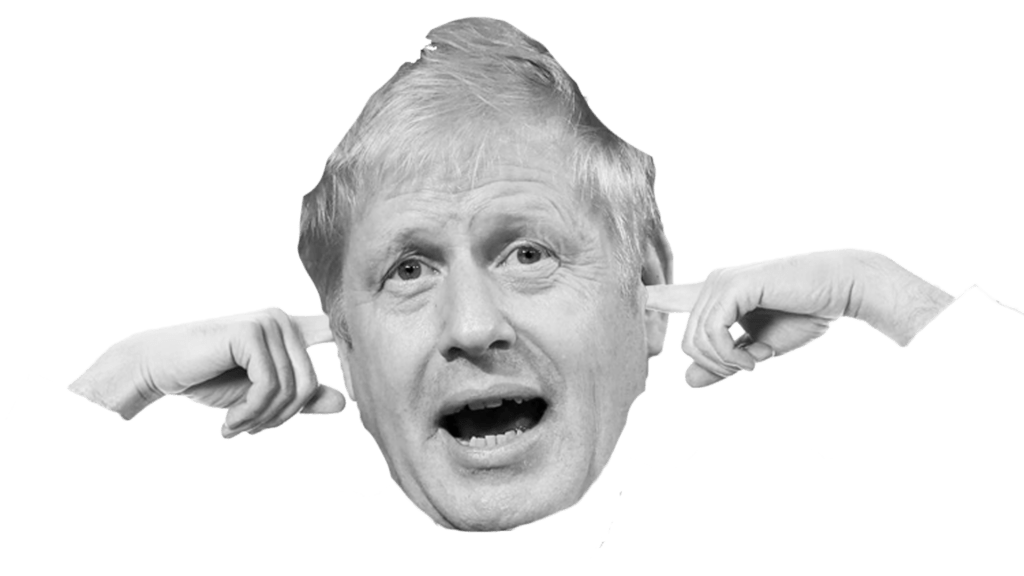
The election of Boris Johnson as Conservative leader in July last year has understandably given cause for concern, given his track record of making inflammatory comments about Muslims and Islam.
His article for the Telegraph in August 2018, which likened Muslim women who wear the burka to “letterboxes” and “bank-robbers”, was feted by anti-Muslim figures and displayed a callous disregard for the impact his words might have had on a vulnerable minority group.
A number of other offensive articles he’d written over the past two decades also garnered renewed attention, including one in which he proclaimed: “… the problem is Islam. Islam is the problem” (The Spectator, 2005). Provocative and indiscriminate statements such as these hardly inspire confidence that Mr Johnson is committed to tackling anti-Muslim sentiment in his party.
A number of the party’s candidates in December’s General Election were revealed to have made Islamophobic comments on social media, too. There have also been a deluge of allegations against local councillors.
Dossiers compiled by the Guardian and LBC showed evidence of anti-Muslim and racist posts on social media by more than 30 current and former councillors, including claims that Muslims were “barbarians” and the “enemy within”, as well as promoting Islamophobic conspiracy theories. These included notions such as the existence of supposed “no-go zones” for non-Muslims and the idea that Muslims have been infiltrating public life in order to “take over”.
The Conservative Party claims that it takes immediate and decisive action when such claims emerge, and made an unspecified number of suspensions as a result of these dossiers. Yet the disciplinary processes that follow these suspensions remain opaque, with the party claiming that confidentiality prevents it from providing details of any individual cases.
A Guardian report in March last year showed that 15 councillors who had previously been suspended for racist and Islamophobic behaviour had been quietly readmitted, despite the-then party chairman Brandon Lewis publicly criticising similar behaviour by Labour.
Recently readmitted councillors include Jeff Potts from Solihull, who was suspended for having retweeted a call for all British Muslims to be deported, and David Abbott of Houghton Regis, who was suspended for comments on social media about “the infiltration requirements of Mohammedanism” and suggested that Muslims were “breeding for Islam”. While the Conservative Party insists that both men have apologised and undergone diversity training, it is legitimate to ask whether such actions amount to more than a box-ticking exercise, with eventual readmission as a foregone conclusion.
There were also numerous reports of complaints made to party HQ that had been either ignored or effectively stonewalled, with victims of discrimination feeling forced to resign from the party in protest.
In March 2019, HOPE not hate’s chief executive Nick Lowles wrote to Brandon Lewis to demand an explanation, in light of the fact that Lewis had stated in a tweeted reply to HOPE not hate in November 2018 that there were “no outstanding cases [of Islamophobia complaints]”.
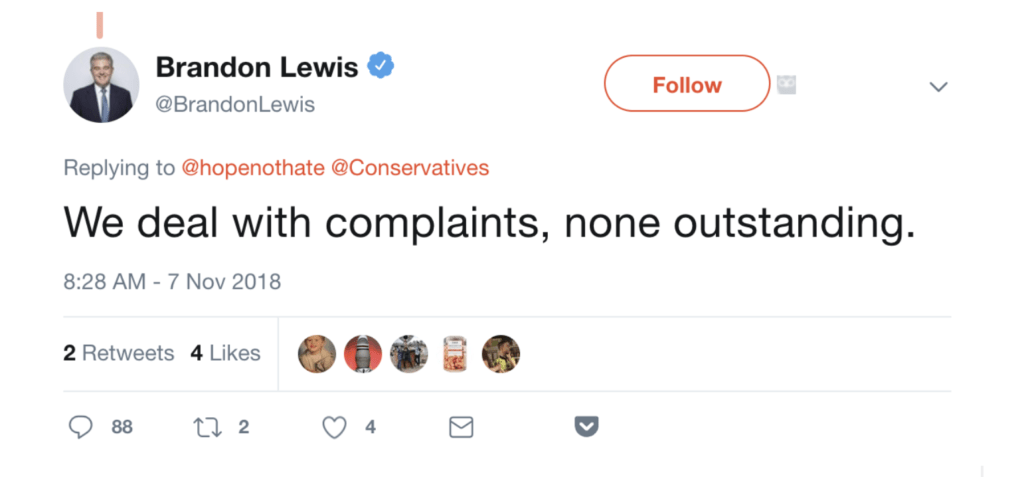
A number of news reports emerged over the course of 2019 that revealed unresolved complaints made prior to this tweet, which you would expect the party Chair to know. One complaint had come from Ajay Jagota, a local Conservative chair in South Shields, who had been subject to anti-Muslim abuse by a Tory councillor. Despite having raised his complaints with Brandon Lewis in person at the party conference in September last year, Jagota eventually resigned his party membership in January, after failing to receive a reply to his numerous follow-up letters.
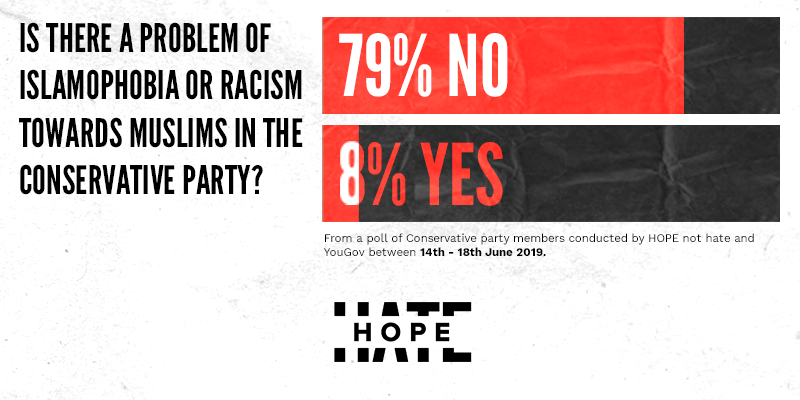
Polling of Conservative Party members carried out by YouGov on behalf of HOPE not hate in 2018 and 2019 consistently found worryingly high levels of Islamophobic sentiment and false perceptions about Muslims among Tory grassroots members.
Over three-quarters – 67% – of members polled believed that “there are areas of the UK that operate under Sharia Law”, while a staggering 60% said that “Islam is generally a threat to Western civilisation”.
Nearly half – 45% – believed that “there are areas in Britain in which non-Muslims are not able to enter”, and over half – 54% – thought that Islam was also “generally a threat to the British way of life”. Meanwhile, a worryingly high 43% said they would “prefer to not have the country led by a Muslim.
Brandon Lewis rejected the conclusions of the polling, by casting doubt on both the sample size and self- reported status of YouGov’s membership data, despite having approvingly cited previous YouGov polls of Tory members. Rejecting such polling out-of-hand, particularly from such a widely respected pollster, does not seem indicative of a party leadership that is genuinely committed to tackling the issue of anti- Muslim prejudice.
The findings of the polling also appeared to tally with media reports of large numbers of Conservative Party members being reported for making similar anti-Muslim statements on social media. In July, ITV News handed a dossier to Conservative HQ containing abusive anti-Muslim social media posts from over 200 alleged party members. While the party denies that some of the individuals in these dossiers are members, it has consistently refused to provide the actual number of complaints they’ve received – citing confidentiality issues – despite Labour providing regular data on its own complaints statistics.
Much of the anti-Muslim social media activity reported to the party appears to be taking place in Facebook groups that were set up to support either the party itself or specific Tory MPs, appearing in groups such as the ‘Jacob Rees-Mogg: Supporters’ Group’, of which Cllr Abbot (see above) was and remains a moderator.
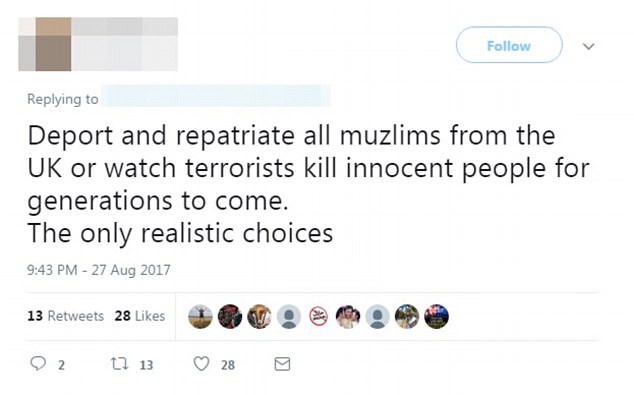
Such groups are not directly controlled by or endorsed by the Conservative Party or the MPs they support, and Rees-Mogg himself has specifically condemned the anti-Muslim content of the group. Yet the fact that pro-Conservative groups with thousands of members can be home to such large quantities of unchallenged anti-Muslim hatred should be a matter of great concern to the party.
December saw the Conservatives announce the launch of an investigation into the handling of complaints relating to all forms of prejudice, including Islamophobia. While any form of investigation is to be welcomed, the remit of this investigation is both too narrow and too broad to address the scale of the problem they face.
Limiting their investigation only to the handling of complaints, and expanding the remit to include all forms of prejudice, does not demonstrate a willingness to tackle the specific and widespread problem of Islamophobia in the party, and HOPE not hate will continue to demand a full inquiry and decisive action.
It is tempting to dismiss conspiracy theorists as harmless eccentrics, gathering in dingy pubs and online forums to discuss peculiar, but ultimately ineffective, ideas. However, the tendency to mock and to minimise the threat posed by conspiracy beliefs gives them the space to spread, despite the fact that this dangerous mode of propaganda can be used to scapegoat and to justify attacks on particular target groups. In an age in which conspiracy theories continue to flourish, it is only by understanding both the allure and the threats posed by this widespread and persistent form of false belief that we can begin to tackle it in a meaningful way.
As Michael Barkun outlines in his work A Culture of Conspiracy: Apocalyptic Visions in Contemporary America, a “conspiracy belief is the belief that an organisation made up of individuals or groups was or is acting covertly to achieve some malevolent end”. Believers in conspiracy theories tend to reject official versions of the truth, to read intention into seemingly random events, and to view unrelated events as interconnected.
As such, conspiracy theories provide a framework for interpreting unpredictable and bewildering events across the world, tending to spike in popularity during times of turmoil, crisis and upheaval. In the 21st century, the UK has experienced unpopular wars, terror attacks, a financial crash, a decade of austerity and years of divisive and painful Brexit proceedings. In relation to the surge of conspiracy thinking in the US, Anna Merlan, author of Republic of Lies: American Conspiracy Theorists and Their Surprising Rise to Power, points to the hardening class structure, increasing disenfranchisement, disappearing social safety net and complex healthcare system as contributing factors. Circumstances on both sides of the Atlantic have led many people to feel that they lack agency in their own lives, and some have sought a strange form of solace in conspiracy theories. This way of thinking personifies the hardship and danger in people’s day- to-day experience, and therefore enables blame.
There is a frisson that accompanies uncovering supposedly forbidden information, and the sense that one is unravelling some hidden scheme can be addictive. David Aaronovitch, author of Voodoo Histories: The Role of Conspiracy Theory in Shaping Modern History, also highlights a narcissistic element, as conspiracy theories enable believers to inhabit the role of selfless “truth-seekers”, heroically struggling against shadowy forces, and superior to supposedly sheep-like, brainwashed public that accept the false official versions of events. In our era of “fake news”, where hostility to authorities and traditional gatekeepers is widespread, the feeling of empowerment arising from the belief that one possesses the “real” truth can be highly attractive.
The automatic mistrust of information provided by governments, the media, universities and other institutions means that conspiracy beliefs can be exceedingly difficult to tackle. As Barkun notes, conspiracy theorists can accuse mainstream accounts of being fabricated false reports, rendering their beliefs impervious to contrary evidence. Moreover, the messianic self-stylings of conspiracy theorists such as David Icke mean that efforts to limit the spread of their ideas, be it through negative press coverage or other forms of perceived “censorship”, often simply reaffirm the belief that they are the victims of a conspiracy to silence them. This in turn can nourish martyr complexes, and further entrench the beliefs of their followers.
This is a cause for genuine concern in light of the negative impact conspiracy beliefs can have in society. For example, misdiagnosing the root cause of genuine social injustices can mean that the energy of dedicated, potentially progressive activists are directed into worthless causes, derailing opportunities for manifesting real change. Additionally, in the social media age, key events, debates and votes are reliably accompanied by a swirl of misinformation and conjecture which obscures truth. This can mislead or even paralyse action through sheer confusion.
Most worrying, however, is the use of conspiracy theories as a tool to attack minority groups. Of course, belief in a conspiracy theory naturally entails belief in sinister conspirators, often portrayed as possessing an almost superhuman degree of cunning. While the identity of these alleged conspirators varies according to the theorist, there is one group in particular that has, for centuries, faced blame for an enormous variety of upheavals, tragedies and calamities, both historical and mythic. Jew-hatred has deep roots within the tradition of alternative conspiracy thinking, and while the so- called “Jewish Question” is hotly debated among conspiracy theory communities, antisemitic tropes are rarely far removed from a diverse array of conspiratorial notions, concerning, for example, 9/11, the refugee crisis or even climate change.
The persistence of antisemitism within the 21st century conspiracy scene partly stems from its status as a “taboo”. As Barkun writes, for many conspiracy theorists “the greater the stigma, the more attractive the source becomes, for the intensity of rejection is its truthfulness”.
Therefore, if speaking about a notion carries threats of social ostracization, media condemnation or even legal penalties, this only reaffirms its truth, as these consequences are interpreted as elite attempts to suppress forbidden knowledge. As such, susceptibility to conspiracy thinking can be a gateway into darker territories, and the path from ostensibly non- antisemitic conspiracy theories to flirtation with, or open endorsement of, conspiratorial antisemitism and even Holocaust denial, is well trodden.
Yvette Cooper’s speech at the launch of HOPE not hate’s State of Hate report is a timely reminder of the need to unite with one another to challenge the rising tide of hate.
Thank you Nick for inviting me to speak at the launch of this important and sobering report.
The work of HOPE not hate across the country is more important now than ever: monitoring, analysing and campaigning against far-right extremism and hatred.
It requires huge bravery and determination to stand up to hatred and we owe you thanks for it.
From uncovering the plot to murder Labour MP Rosie Cooper to identifying new far right networks online, we cannot underestimate the importance of the work HOPE not Hate do.
Four years ago, after Jo Cox was murdered, the Home Affairs Select Committee which I chair began looking at hate crime and its violent consequences.
A year later we published a report on the failure of social media companies to tackle illegal extremist content and hate crime online, calling for more action. We’ve taken further evidence since and will decide this week what our new committee will look at.
And along the way, we’ve often considered powerful evidence from HOPE not hate – on issues ranging from extremism to cohesion and consensus building.
So I have great respect for the work of HOPE not hate and welcomed the invitation from Nick Lowles to respond to their report on the State of Hate today which should frankly be a challenge to us all.
This year’s State of Hate report shines an important light on what we are up against as we start a new decade.
The threat of far-right terrorism has continued to rise here and around the world
Traditional racist and far-right organisations are at their weakest for years.
But online we have seen the growth of dangerous new far-right networks and movements.
The poison they spread is now increasingly finding its way into mainstream public debate.
And in the face of that, there’s been a failure of mainstream political parties to show proper leadership when racism and prejudice arise – a failure that should shame us all.
And too many of us are standing by while our national resilience, our sense of social solidarity and our sense of public decency that has always been the British bulwark against far-right agitators is being gradually undermined.
Today I want to touch on some of those points and how now we should respond.
The report charts the rise of far-right terrorism across the world.
In Hanau just a fortnight ago, in Christchurch, in El Paso, and across the world, the poison of far-right terrorism has taken dozens of innocent lives in the last year.
In the last seven years here in the UK we have seen three far-right terrorist attacks – including the Finsbury Park Mosque attack and the murder of my friend Jo Cox, an MP on her way to a constituency surgery, something that would have seemed unimaginable in this country only a few years ago.
Seven of the 22 plots that have been successfully foiled in the UK in the last two years were inspired by the far-right.
Across Western democracies, the number of incidents of far-right terrorism in has increased threefold in the last five years
Met’s Assistant Commissioner Neil Basu, the country’s most senior counter-terror police officer, told the Home Affairs Select Committee that far right extremist activity was increasing, including involving links between groups here and far-right groups in Europe too.
It’s why there have been growing far-right referrals to the Prevent programme. And why Counter-terror police have recognised they need new ways of working and more resources to counter both Islamist Jihadist and extreme right-wing terrorism which feed upon each other. We should pay tribute to the difficult and immensely important work they do.
Last week, the Home Secretary announced that two far-right extremist groups would now be proscribed – Sonnenkrieg Division and System Resistance Network.
Those decisions are welcome.
But the new evidence outlined today from HOPE not hate about the Order of Nine Angles is even more disturbing.
The evidence they have gathered shows it to be a group which advocates the most extreme sexual violence and murder, and propagates the most vile antisemitism and which has links to terrorist offences.
The case Hope Not hate have made for proscribing the Order of Nine Angles is a powerful one.
Which is why the Home Secretary should immediately refer it to the Government’s Proscription Review Group – the proper process for proscribing a dangerous organisations.
Action needs to be taken to prevent them grooming and radicalising other people.
Behind the rise in far-right terror threats is a changing pattern of far right extremism, rising hate crime, the promotion of far right ideology online and changing patterns of racism and prejudice.
Former Met Counter terror chief, Mark Rowley said back in 2017, “The ease and speed in which vulnerable people can be radicalised through online propaganda and then move to attack planning has been a shocking feature of many of our cases.”
As we saw in the Finsbury Park attack, and many of the international far right attacks too.
What starts with hateful and bigoted ideas from high profile far right personalities that go unchallenged online can end up leading people to the darkest and most dangerous places, cesspits of hatred and extremism.
In the most extreme cases, vulnerable individuals end up on social media channels that promote violence – including terrorism and sexual violence.
The Met’s current counter terror chief, Neil Basu has warned that the most dangerous threat often comes from “malleable, vulnerable people [that] are being sucked very quickly into this ideology and often having no touch-points with the rest of society”
In evidence to the Select Committee, he also warned that “as a proxy for where the country is going in terms of tolerance, rising hate crime must be seen as a very disturbing indicator”.
Today’s State of Hate report provides a wide-ranging account of the way in which far right extremism is promoted online and through social media.
Social media is amazing. It gives us the chance to talk to friends a thousand miles away, to bring people together, to build progressive communities and networks, to promote new ideas, to provide each other with solidarity.
But it can also be poisoned. At their worst, alternative platforms such as Telegram and 8chan can be used to incite and organise violence and promote terrorist propaganda, training manuals or instructions for carrying out attacks. Even the big mainstream social media channels are too often manipulated by far-right figures to radicalise people and to stir up hatred and division that is corrosive to our trust in each other and in our way of life.
The Government has promised legislation to tackle online harms. The most harmful but also some of the hardest to tackle are some of these smaller, alternative platforms. But this is the area where most international action is needed, seeking different ways to challenge the ways the platforms operate, different ways to protect the public.
Some of the biggest social media companies Facebook, YouTube and Twitter are now doing more to tackle extremism online.
When we first took evidence from them three years ago, we were frankly appalled at how little they were doing, and how little they felt any responsibility to act, despite the fact that their platforms were being used to spread poison, illegal and dangerous material, and to destroy peoples lives, despite the fact that they were profiting from hate.
We found for example the same propaganda videos promoting National Action on YouTube, Facebook and Twitter years after they had been banned, and many months after the same video had been reported by us to them.
Three years on, they are doing far more. And HOPE not hate have documented the positive impact of the decisions they have taken to deny certain extremists or groups the power to broadcast for free to millions of people.
But serious problems remain.
Facebook still need to get a grip on the closed and secret groups sharing hate and dangerous, offensive and illegal content, often to tens of thousands of members, which is used to incite violence and criminal behaviour.
And YouTube need to get a grip on the way their algorithms are working to promote hatred.
Last night we set up a new YouTube account and searched for one of the groups listed in HOPE not hate’s report Millennial Woes. YouTube immediately recommended we watch videos of Tommy Robinson (who they claim not to be promoting) and lots and lots of videos of Nazis.
Look up one thing out of curiosity, and YouTube is ever willing to offer far, far more – often getting more extreme with every click.
Don’t tell me YouTube can’t tackle this. Google that owns YouTube is king of the algorithm. And one of the richest companies in the entire world. They can do anything to algorithms they want. Instead one of the biggest companies in the world has become an organ of radicalisation, that makes money out of promoting ever more extreme material to keep us watching and suck people in.
It is shocking and immoral. And if Google wont sort this, the Government with its new online harms legislation must.
But there’s a responsibility on the rest of us too, and particularly those of us in public life.
The most shaming part of all in this year’s State of Hate report is on racism in Britain’s mainstream political parties.
As the report says, the Conservative party is yet to solve its systemic Islamophobia, and Labour has only begun to make headway on its antisemitism problem. The past year also saw a new far-right.
It would be heartbreaking if it wasn’t so horrifying.
The two biggest parties in Britain, between them they have been in Government for more than a century.
Labour, the party that brought in the Race Relations Act, the Macpherson Review and the Equalities Act, now being investigated by the EHRC for antisemitism, the oldest hatred of all.
At a time when antisemitism seems to be on the rise across Europe, our party isn’t leading the charge against it, we are complicit in its rise.
And the Conservatives, the party that appointed the first Muslim woman to serve in Cabinet, refusing to face up to its own problem of Islamophobia amongst its members.
At a time when Islamophobia is on the rise across Europe, the party of Britain’s government isn’t leading the charge against it – it is blind to it.
Our public institutions should be the bulwark against extremism.
Our biggest political parties are failing in that task.
And so, both parties need to show humility, commit to changing and sort it out. And that means being willing to face up publicly to the scale of the problem.
For Labour, all our leadership candidates have rightly signed the pledges for action drawn up by the Board of Deputies, but we have to prove ourselves with action – including independent, transparent complaints and proper leadership to rebuild the trust of Jewish communities.
The struggle against racism and prejudice is in the DNA of our Labour party. We passed the Race Relations Act, to tackle discrimination on “grounds of colour, race, or ethnic or national origins” wherever it was found in British society. And at the start of the last decade, we introduced the Equality Act to enshrine in law the protection of individual rights and the principle of a fair and equal society. But we will not have earned back any moral authority on racism and prejudice until we have drummed every strain of antisemitism out of our party.
And the Conservatives will not rebuild trust with Muslim communities across the country or have any moral authority on tackling racism or injustice until they stop denying their problem and open themselves up to a proper independent investigation into Islamophobia in their party.
But the problems in our political debate go far wider than Labour’s problem with antisemitism and the Tories’ problem with Islamophobia.
Former Prime Minister Theresa May warned before she stood down about the “coarsening” of public debate. She said, “Some are losing the ability to disagree without demeaning the views of others…. The descent of our debate into rancour and tribal bitterness – and in some cases even vile abuse at a criminal level – is corrosive for the democratic values which we should all be seeking to uphold.”
In the last twelve months we have seen a 10% rise in recorded hate crime – more than doubling over the last five years.
The Met Commissioner Cressida Dick has said the number of threats faced by MPs is now unprecedented – with the number of cases reported to the police doubling last year.
In one week my office had to report 35 threats to the police.
And I haven’t had the worst of it.
Diane Abbott received almost half of all the abusive tweets sent to female MPs in the 2017 general election.
Jacob Rees Mogg’s children have been bombarded with abuse in the streets.
Luke Pollard’s constituency office has been repeatedly graffitied with homophobic abuse.
And Joanna Cherry had to have a police escort to her constituency surgery after a death threat.
More significantly, people are being driven out or stopped from putting themselves forward to be councillors or MPs in the first place.
And most troubling of all, I know many local campaigners and activists, often not involved in political parties at all, but who were keen to do something practical and local in their own communities who ended up giving up, or going quiet because of the nastiness or abuse from a minority online.
Jonathan Evans, former head of MI5, not one to be squeamish about the tougher threats in life, now head of the Committee on Standards in Public Life, has warned that the pressure exerted on MPs because of threats and abuse would be seen as a serious national security issue if it were done by a foreign state.
It’s time we stopped blaming Brexit for all this, or using Brexit as an excuse.
Too often I’ve heard people who felt strongly that we should remain blame Brexit for the rise in hatred and abuse.
Too often I’ve heard people who felt strongly that we should leave blame the delays in Brexit for rise in hatred and abuse.
Nothing about Brexit should have made any of us, whatever our views on Britain’s future relationship with Europe, start being nastier to each other in the streets or online.
Brexit didn’t cause the rise of antisemitism in the Labour Party. Delays to Brexit didn’t cause the rise of islamophobia in the Tory party. Many of us had begun warning about the increase in misogynistic abuse online here in Britain long before we had a Brexit referendum.
And other countries – from the US, to Australia, to Germany and France – have seen similar increases in online hatred, threats and abuse. Organised threats and intimidation targeted at Julia Gillard, Hilary Clinton or Greta Thunberg are similar in kind to the escalating threats we’ve seen here – and none of them had anything to do with Brexit.
So it’s time we all took some responsibility for our behaviour on and offline without hiding behind the structural relationship between Britain and our European neighbours.
Time our political parties started sorting themselves out.
Time for all of us to pause for breath about the way we treat each other online.
We are British. Normally we are decent. We are compassionate. We are polite.
When we talk to each other we are friendly. Most of the time.
The shouting matches on Twitter. The sneering abuse on Facebook. The continual accusations of betrayal and treachery, simply because others take a different view. I don’t believe this is who we really are. But it is in danger of being who we become.
Because whilst the vitriol comes from all sides, it undermines our resilience, our sense of decency, our respect for our common humanity, our social solidarity.
These are all the things that have always been our British bulwarks against hatred or far-right extremism. The dehumanising of each other that takes place too often online makes it easier for the far-right to exploit and easier for those who are vulnerable to get drawn in.
Instead of undermining our resilience we should be building it up and strengthening the values, institutions and sense of common purpose that have always helped us resist the far right.
And that should come from the top.
Politics should be making things better not worse.
We need to stand up for kindness and respect. For each other and for our opponents, challenging the vitriol that comes sometimes from within our own.
That’s why I’ve called for all parties to agree and sign up to the joint standard of conduct drawn up by the Committee on Standards in Public Life and the Jo Cox Foundation.
We should stand up for the public institutions and ways of working that promote facts, integrity, the rule of law and respect for others.
And yes, that means the independent judiciary, the independent BBC, a free press including strong local papers, an independent civil service.
And why we have to challenge the myth perpetuated by some of those right at the heart of Government (and sadly some of those in our party too) that somehow to be radical you have to be horrible, that to deliver real change you have to be prepared to bully to get it.
It’s rubbish and all of us know it, but it is coarsening debate and corroding our sense of decency.
It’s why the deterioration in the conduct of Government in recent months really matters. The macho briefing about the bullying behaviour of Dominic Cummings, getting armed police to march a young Spad out of Downing street, the briefing war engulfing the Home Office, the allegations against the Home Secretary, the threats made against the independent civil service, the judiciary or the BBC.
Of course, governments can be radical – I hope to see a radical Labour government in future. Of course, there will and must be robust argument, anger at injustice and determination to achieve change.
But it is quite possible to be radical and kind. It is quite possible to be fierce about change and still friendly towards others, to shake up the system and still show other human beings compassion and respect.
On left and right ambition for change doesn’t have to become aggression towards everyone else.
And indeed on the left, the kind of changes we want to see, the better Britain we want to build, should always have kindness, compassion and respect at its heart.
Whilst one of the people later convicted for a threat against me was shouting outside my office, I was marking the Great Get Together with Jo Cox’s family in Birstall.
The best of Britain – bringing together the community. Talking to your neighbours, showing kindness to strangers, going out into parks and streets up and down the country.
For all the anger and argument, we still live in a country where most of our neighbours are kind and would help you if you get into trouble. When you meet people in the street, they’re friendly, smiling and happy to chat. A country which still hates hatred.
A country where volunteers still work to help HOPE not hate stand up to extremism.
All that gives us hope. Decency, kindness, friendliness and compassion in the end always drown out hatred.
As Jo said; “We have more in common than that which divides us”.
Standing up for each other, regardless of race, class, where you live, who you love.
Some will always seek to divide us and spread hate.
That’s why we stand up for kindness and respect. For resilience and social solidarity.
For hope, not hate.

Right-wing comic Kearse saves the worst material for his anonymous Telegram account HOPE not hate has identified an anonymised Telegram account belonging to the GB…